People and their origins The mythology of America

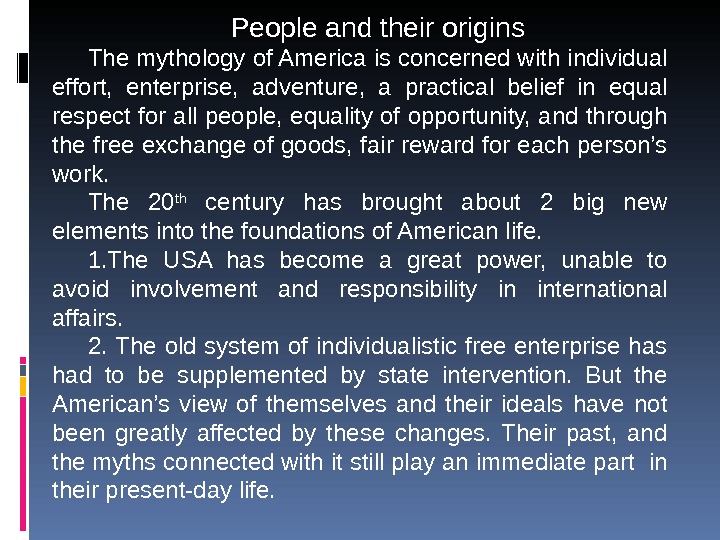
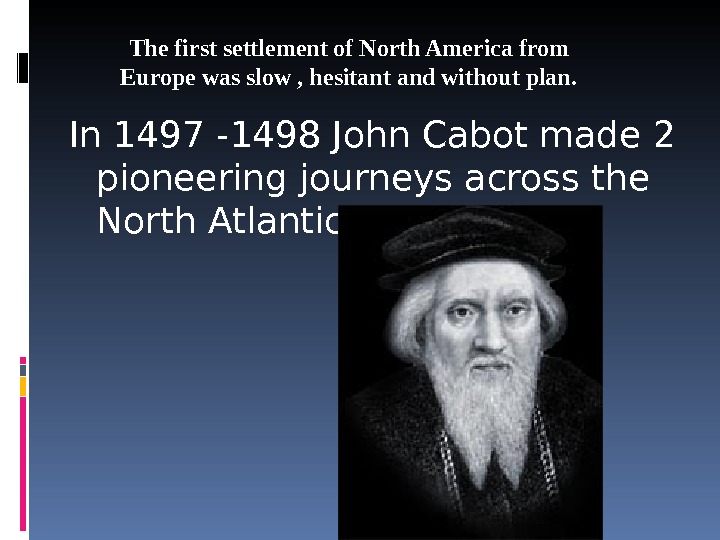

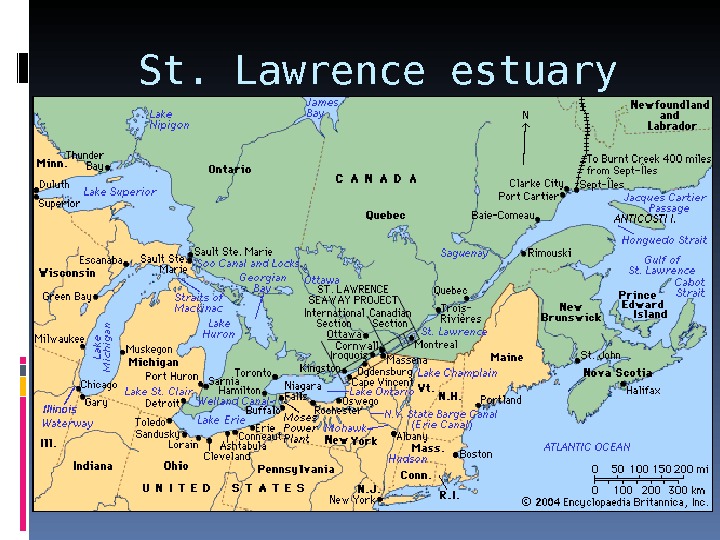

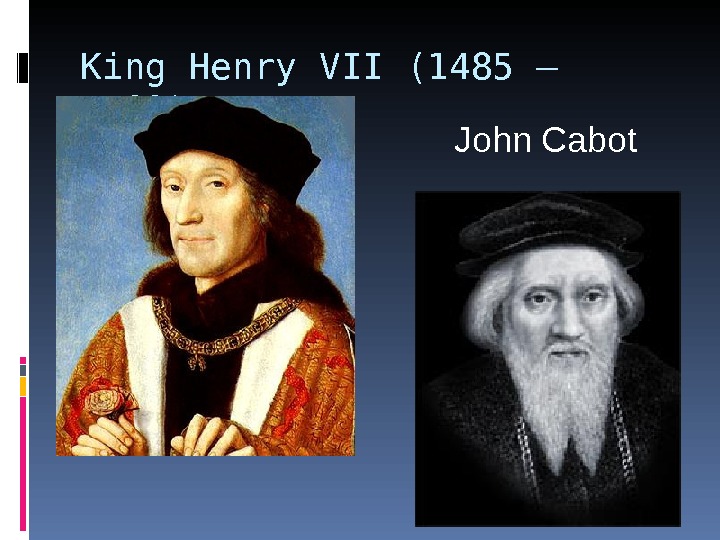
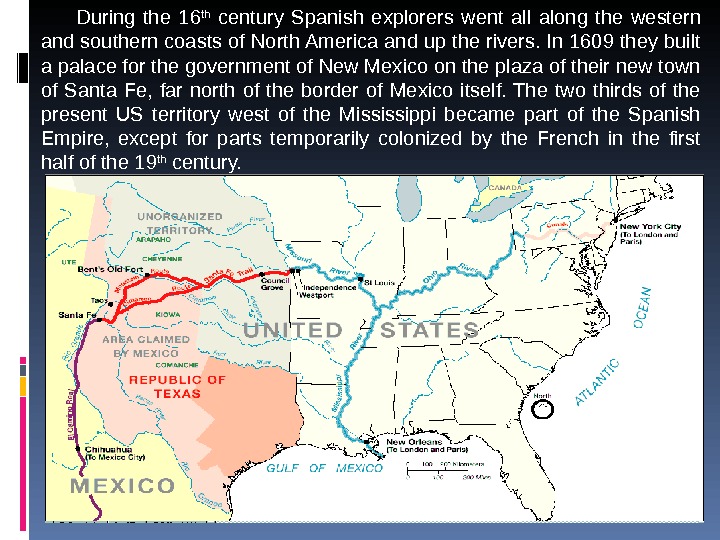
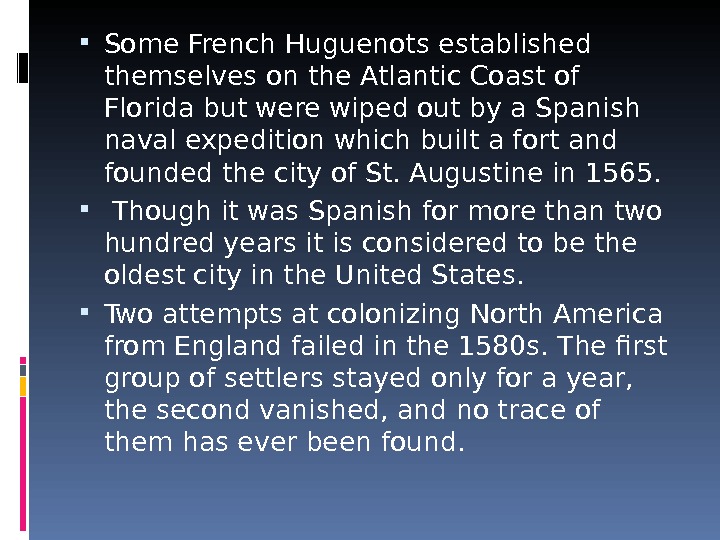
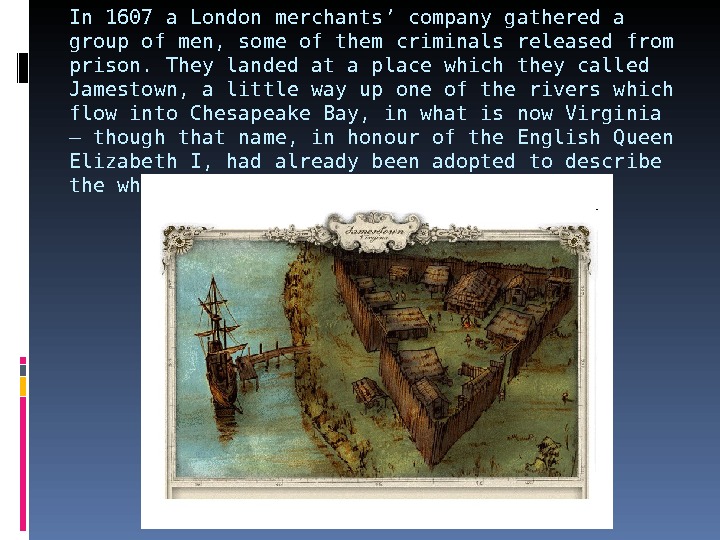
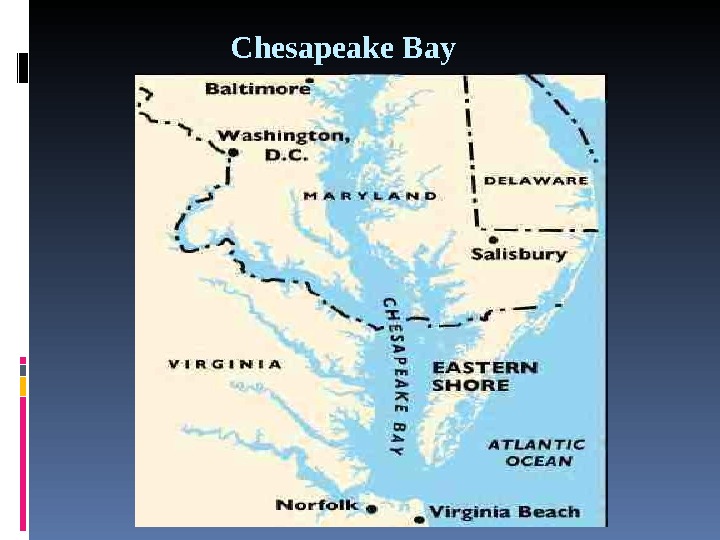
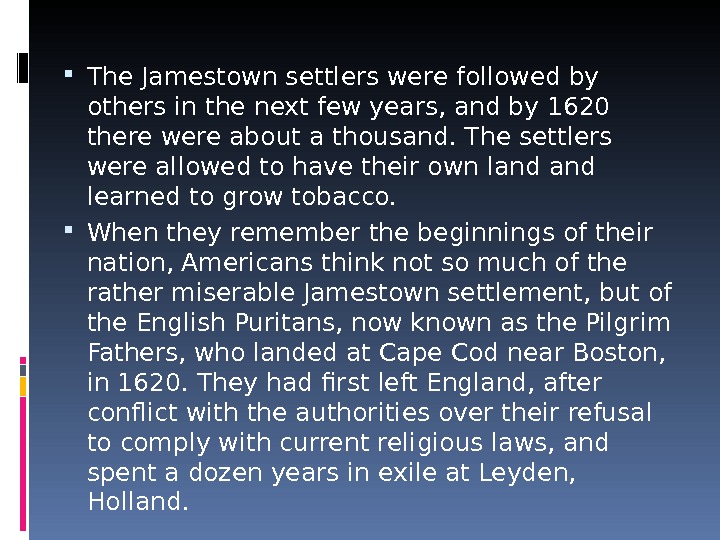
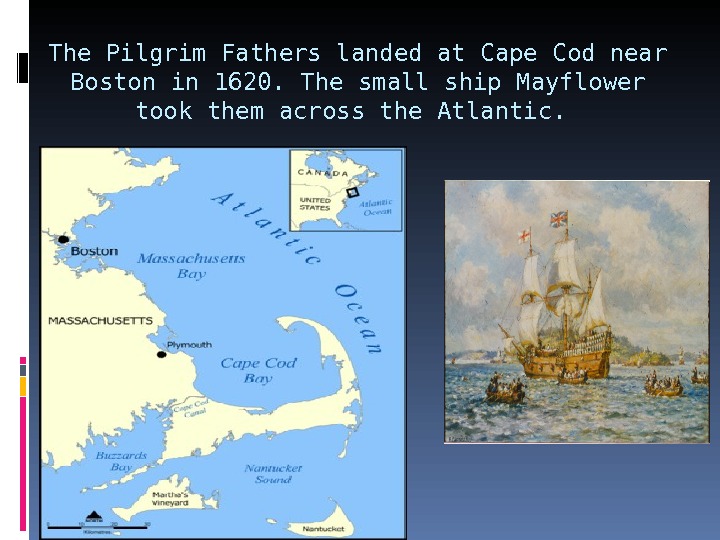
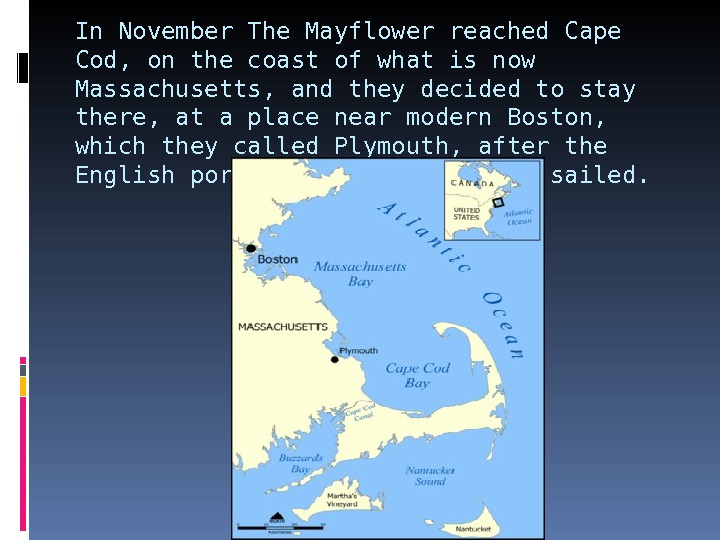

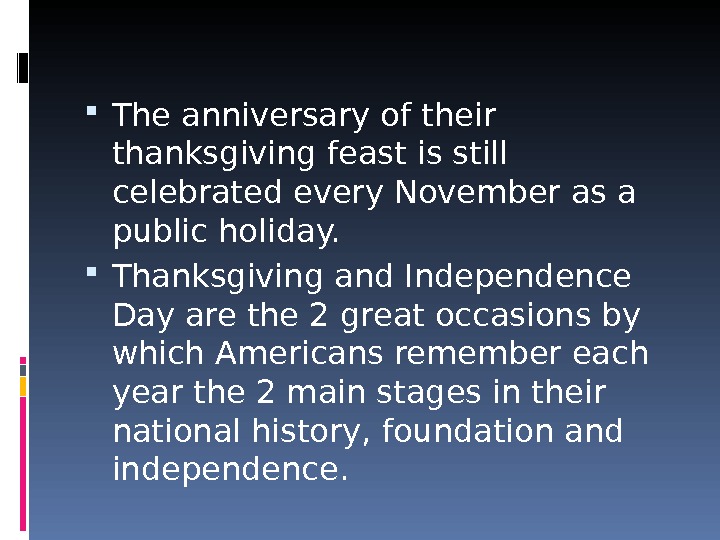
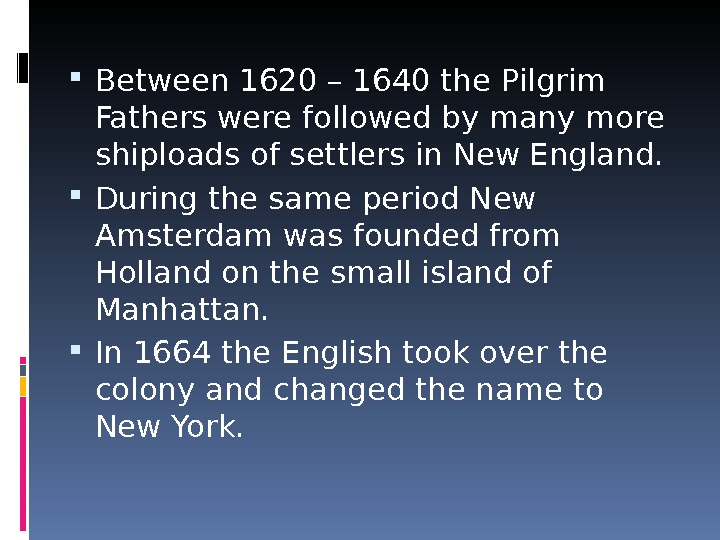
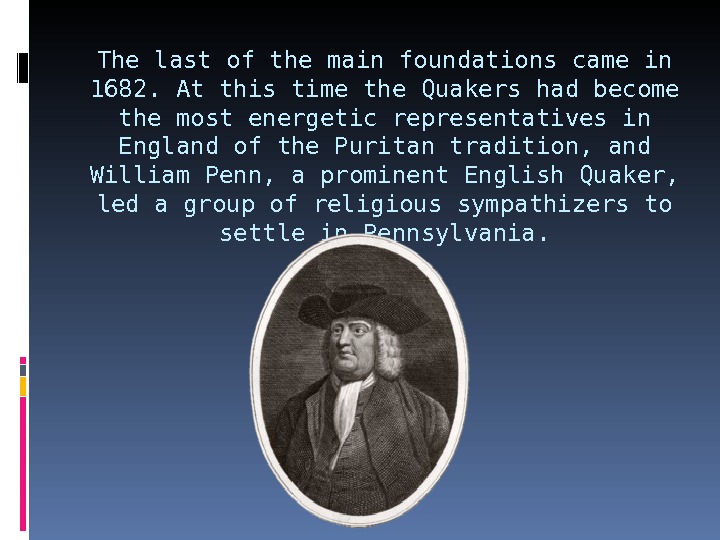


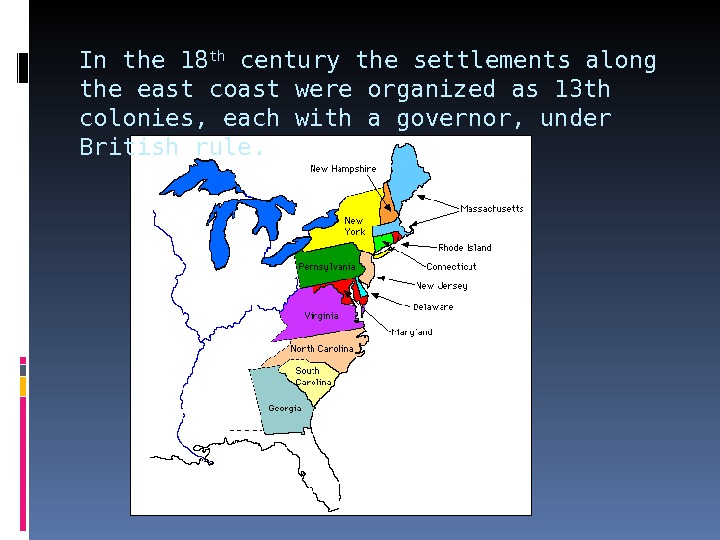

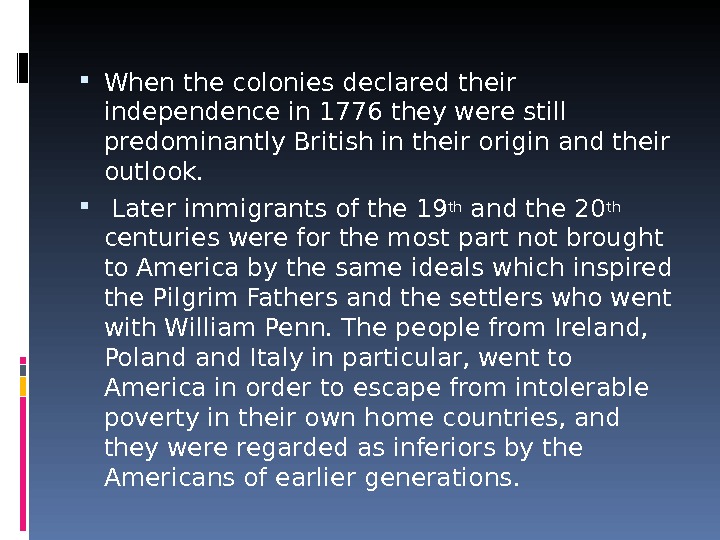

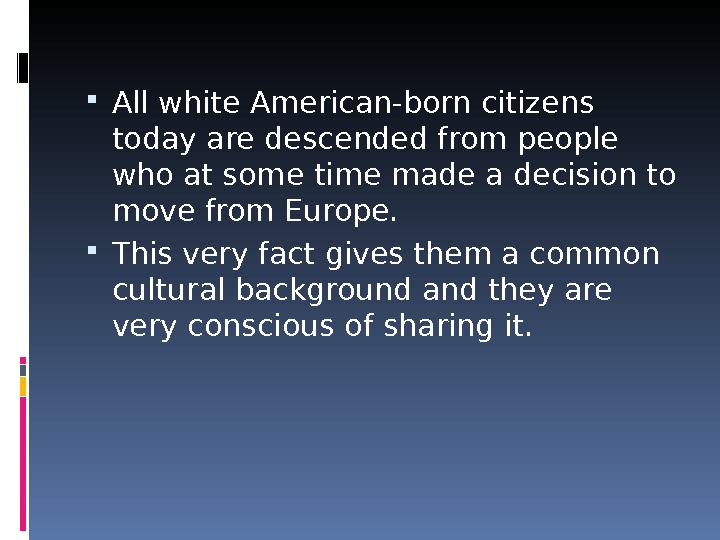

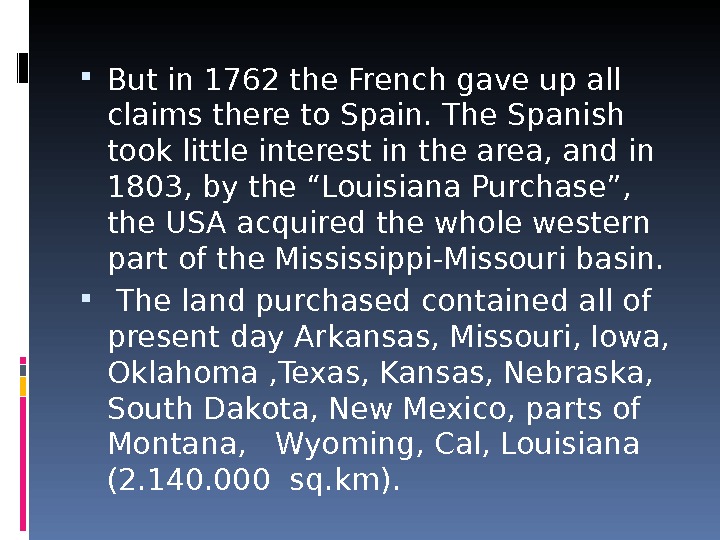
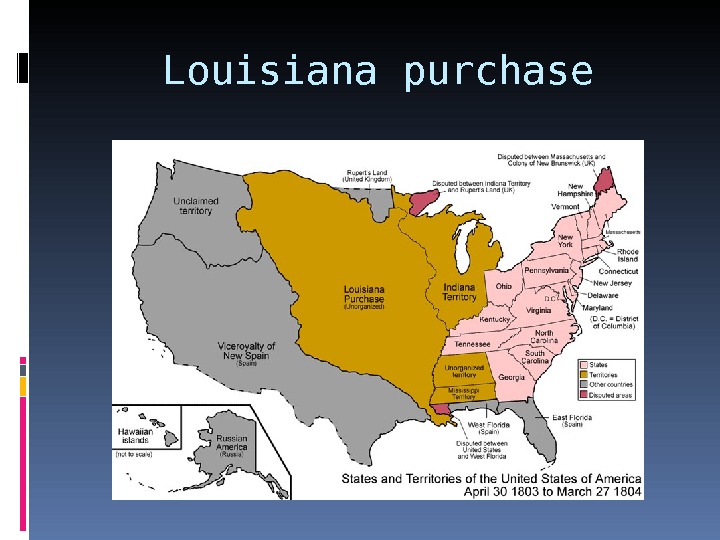
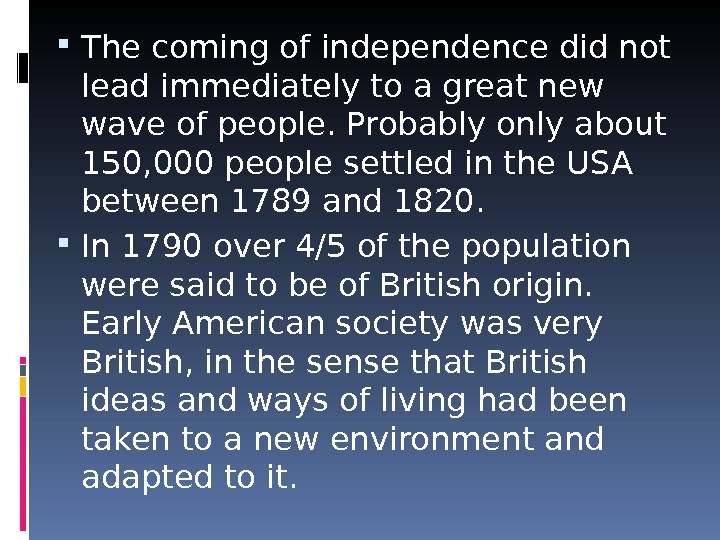
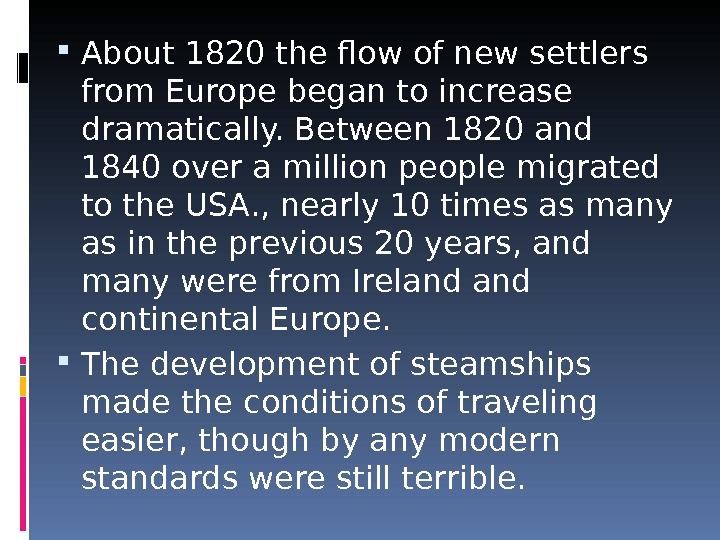
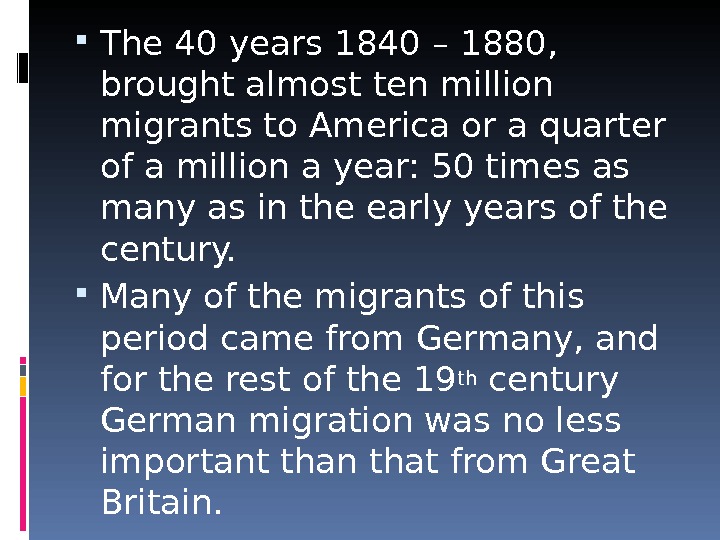
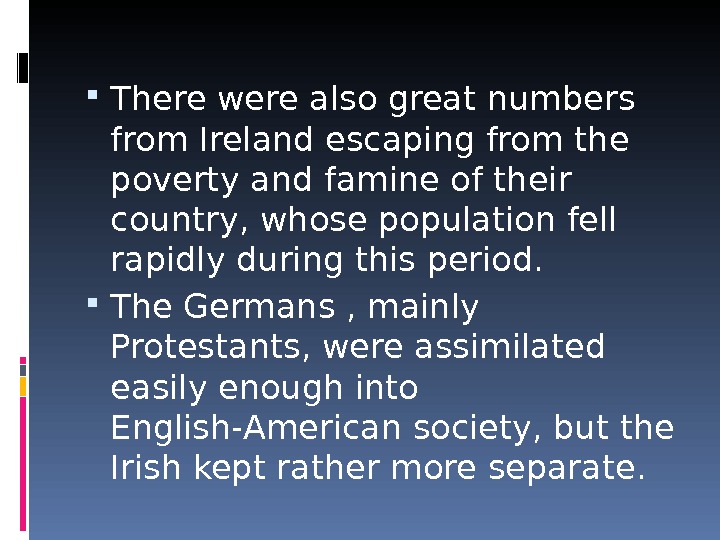
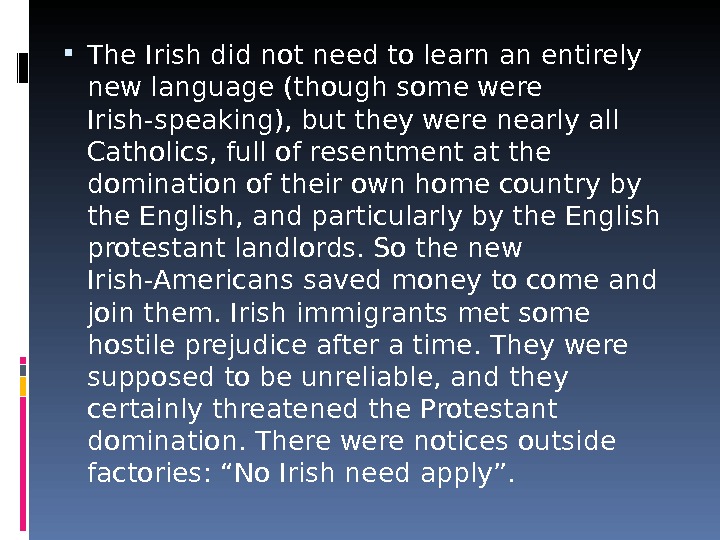
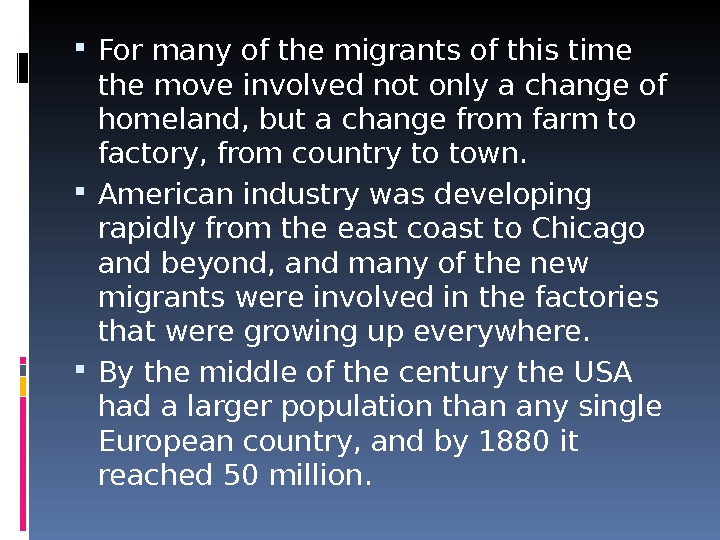
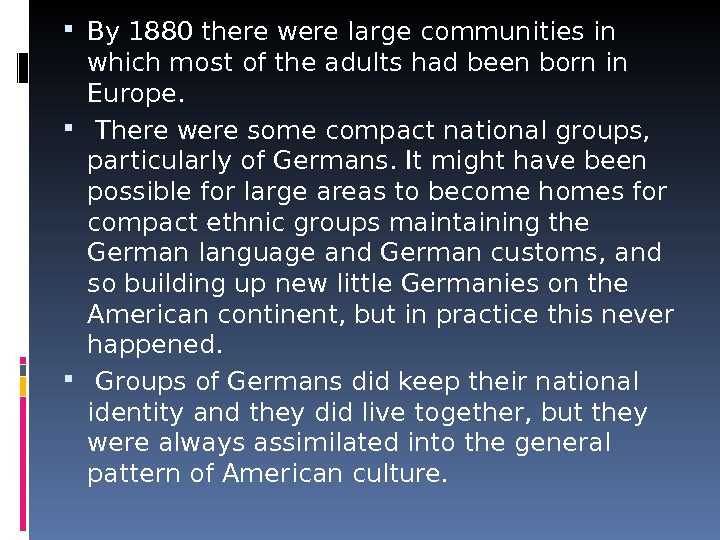
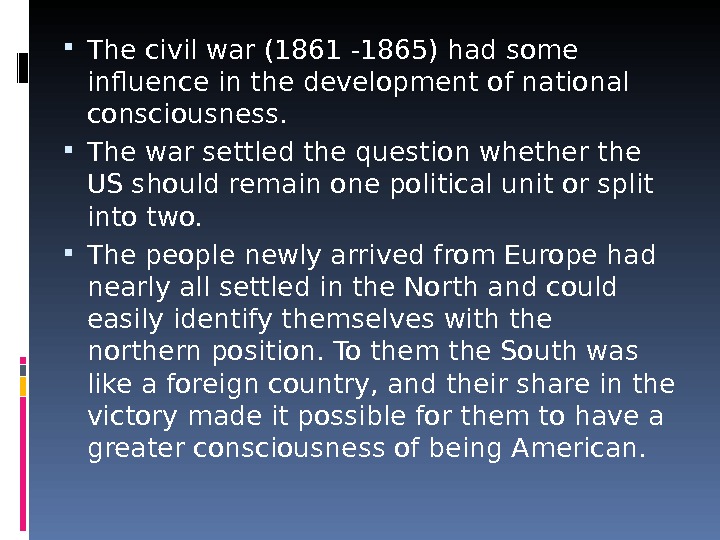
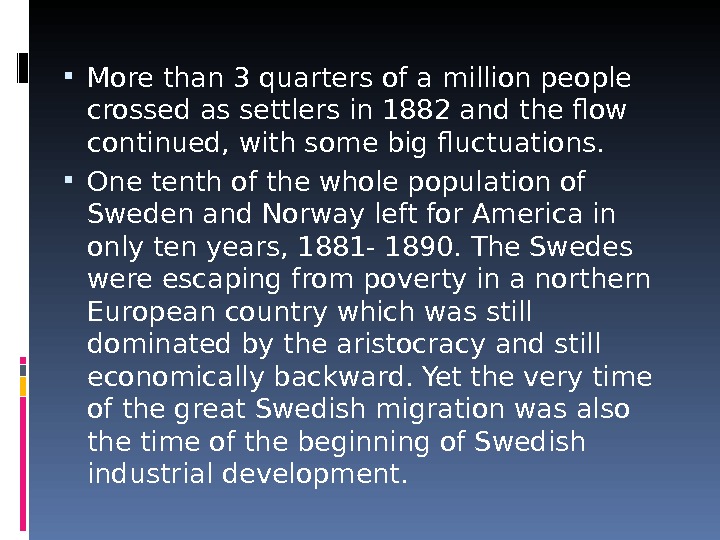
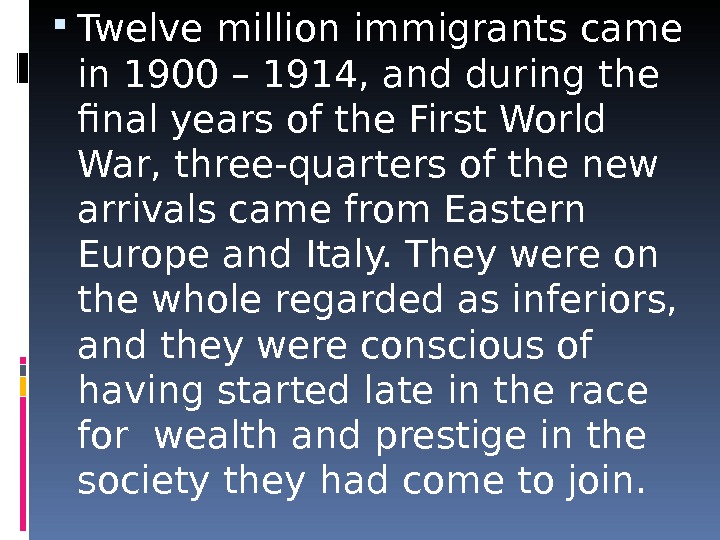
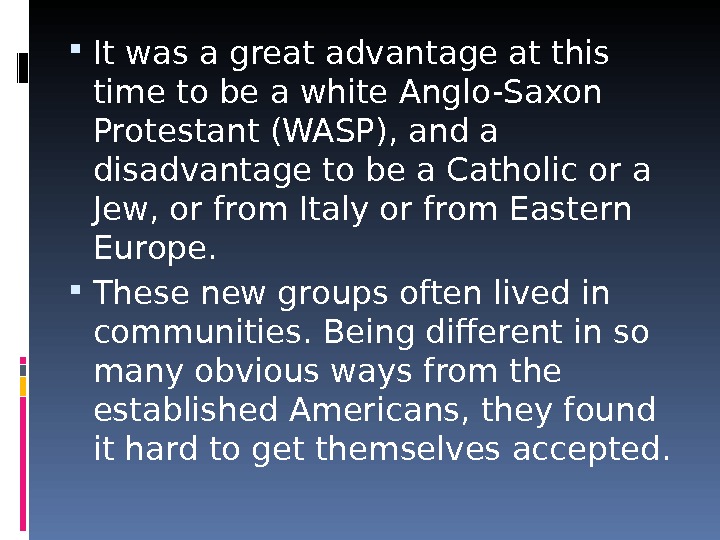
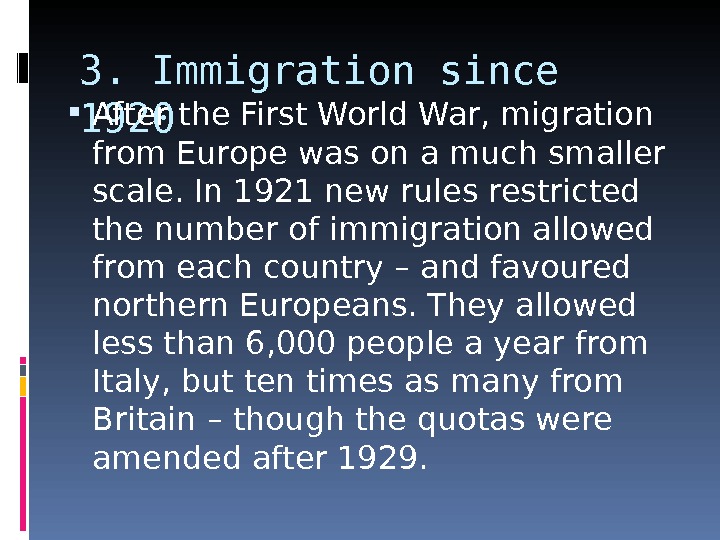


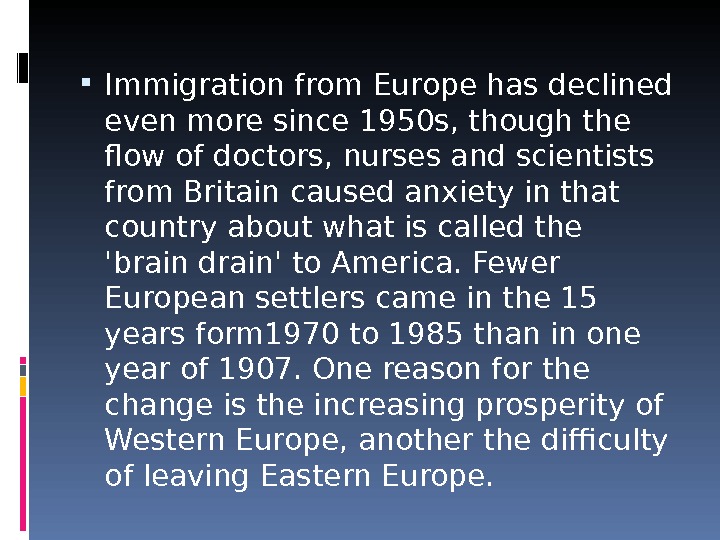
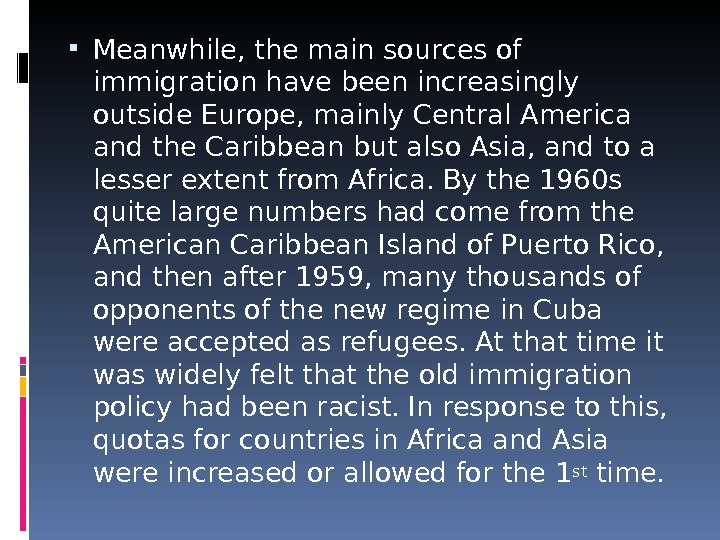
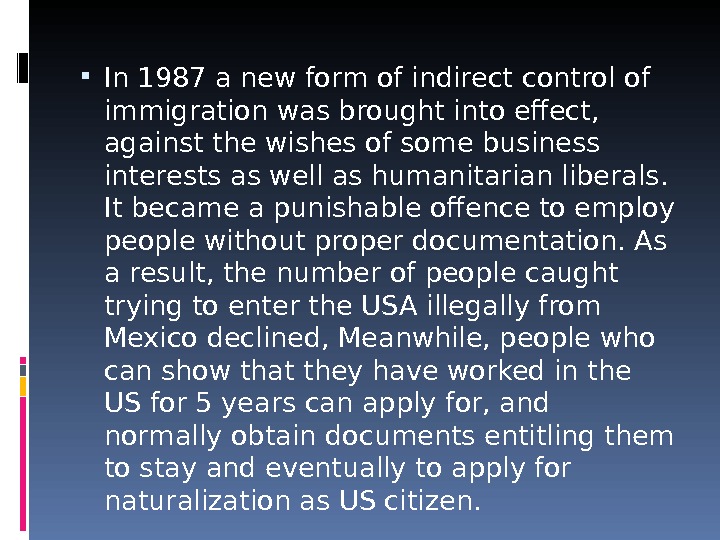
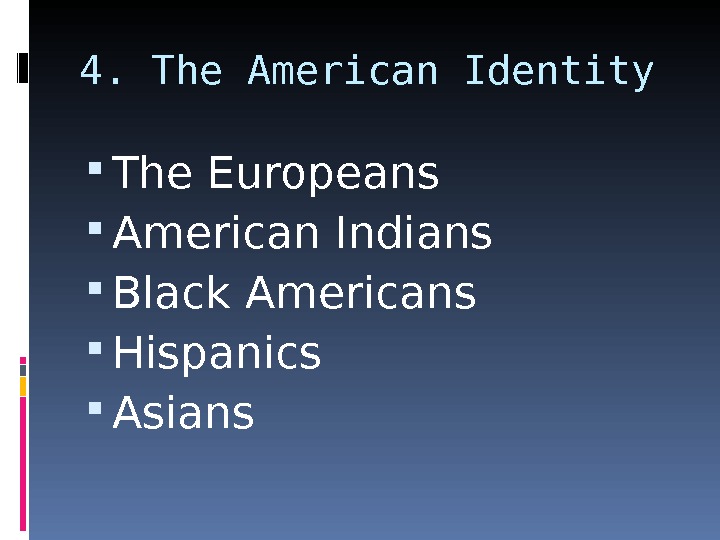
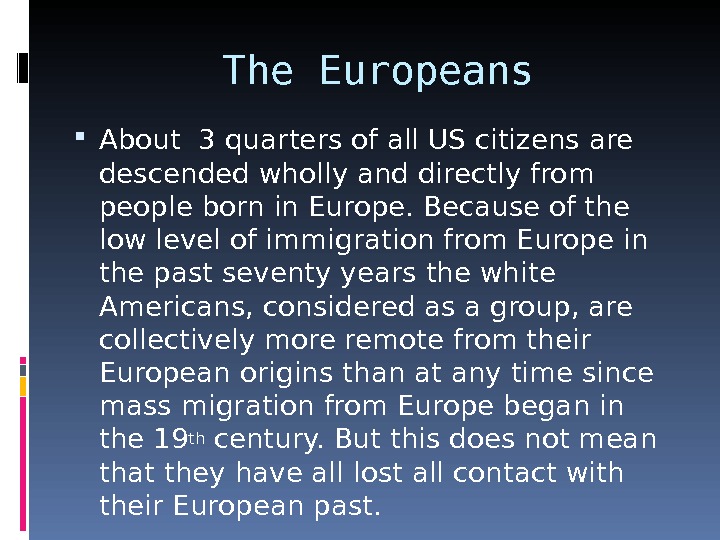
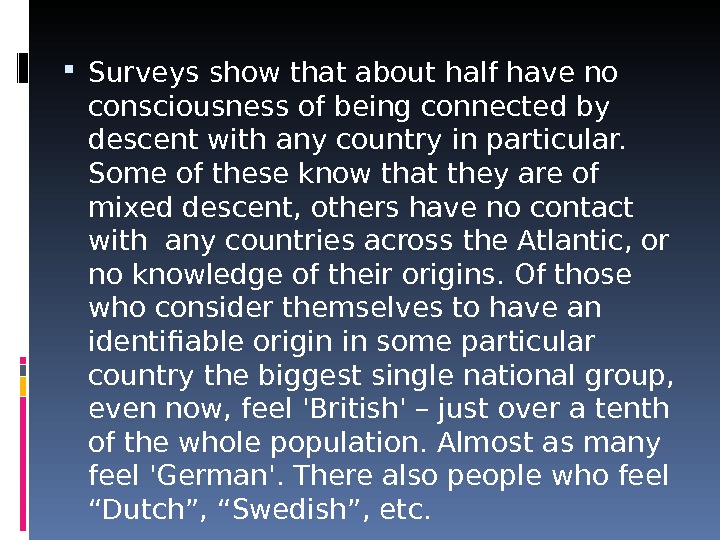
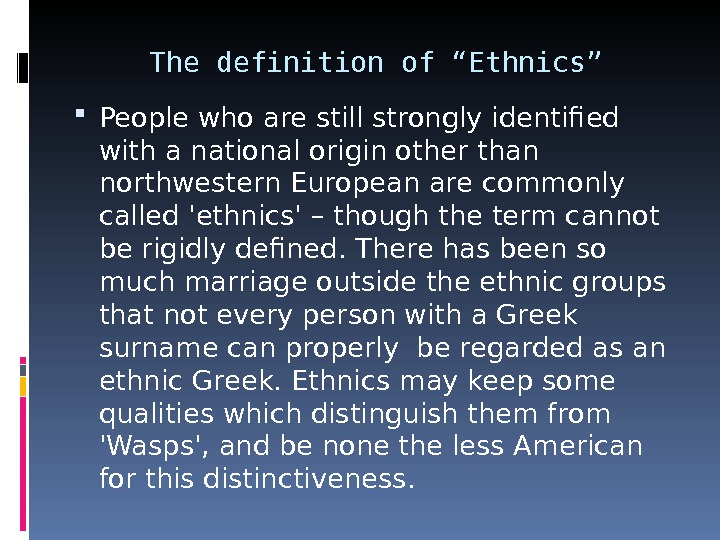
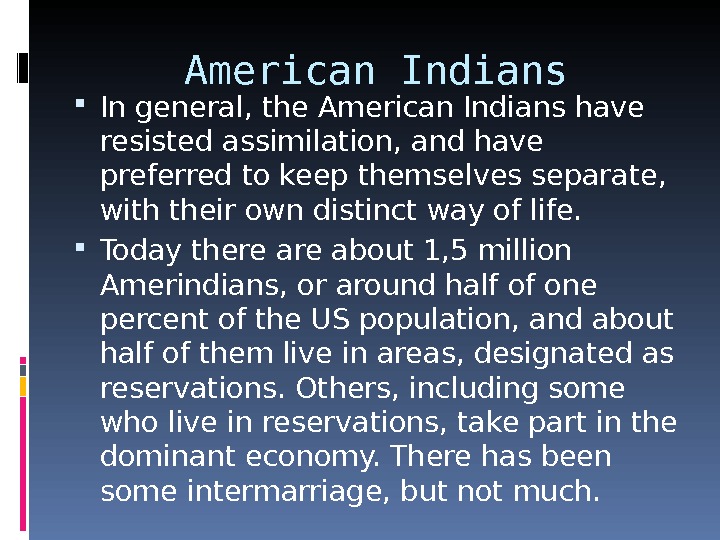
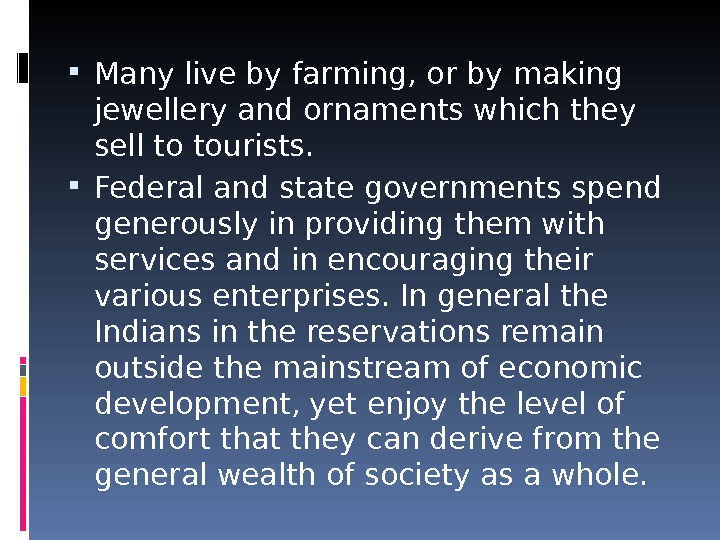
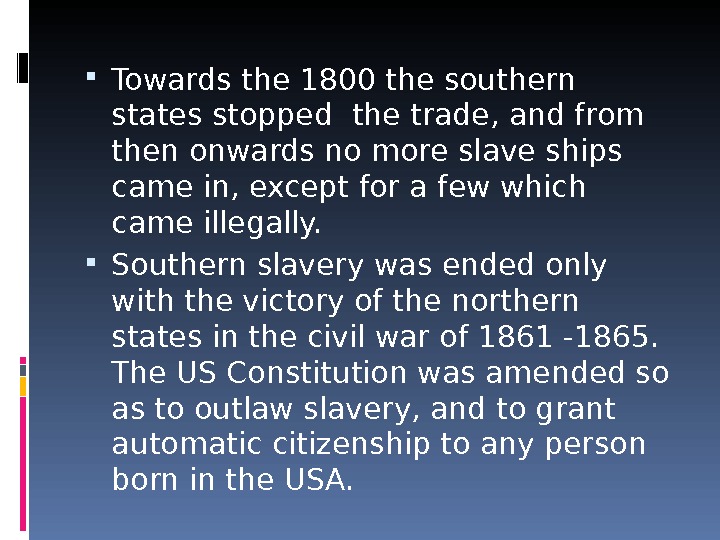
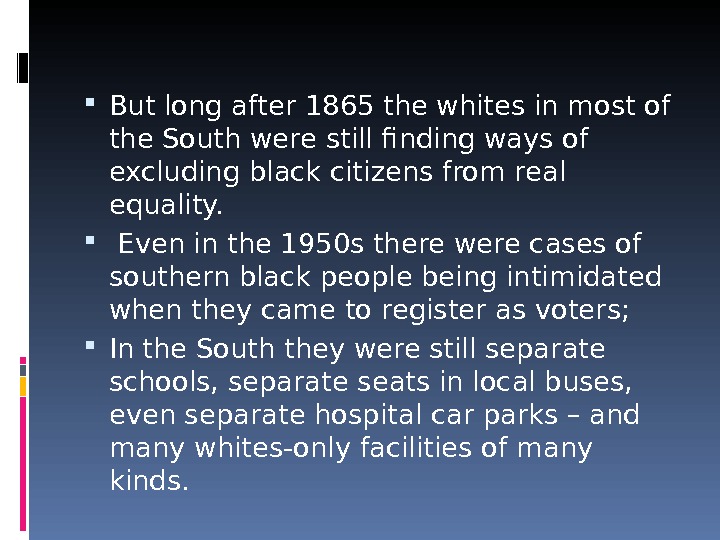
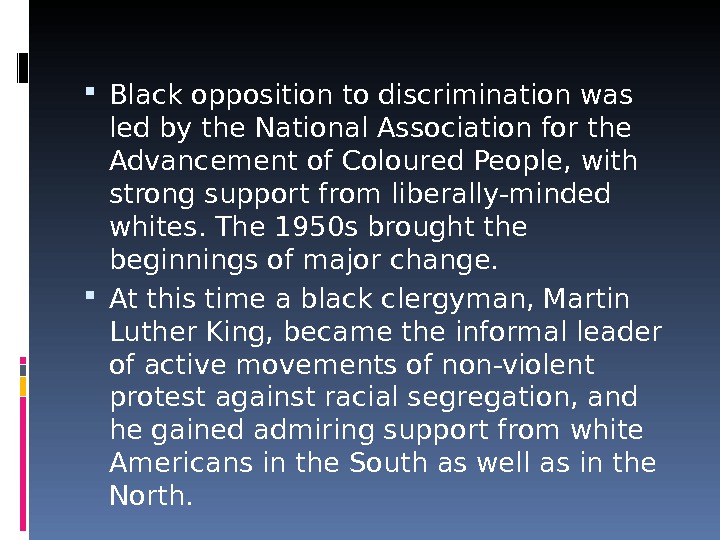
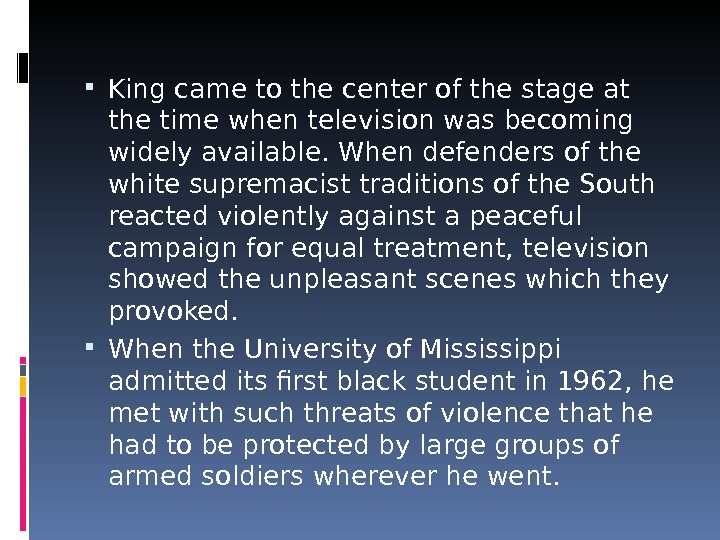
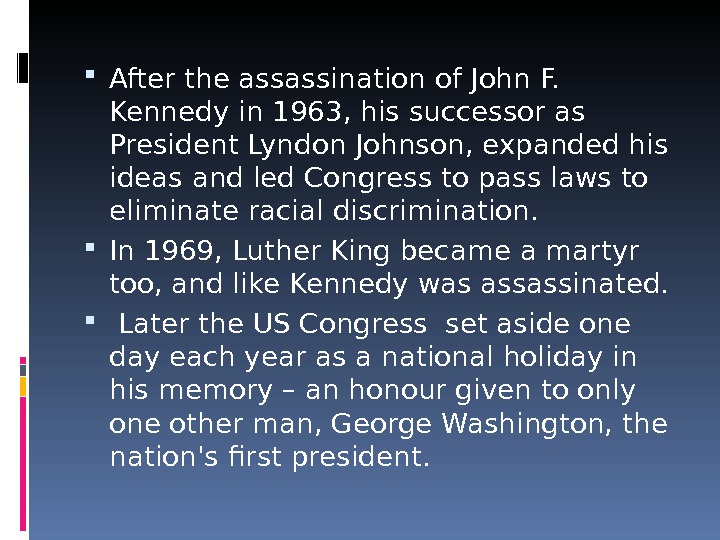
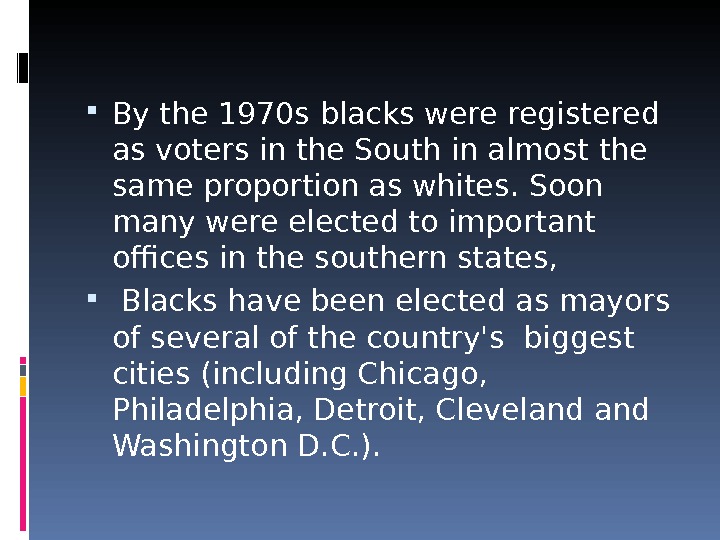
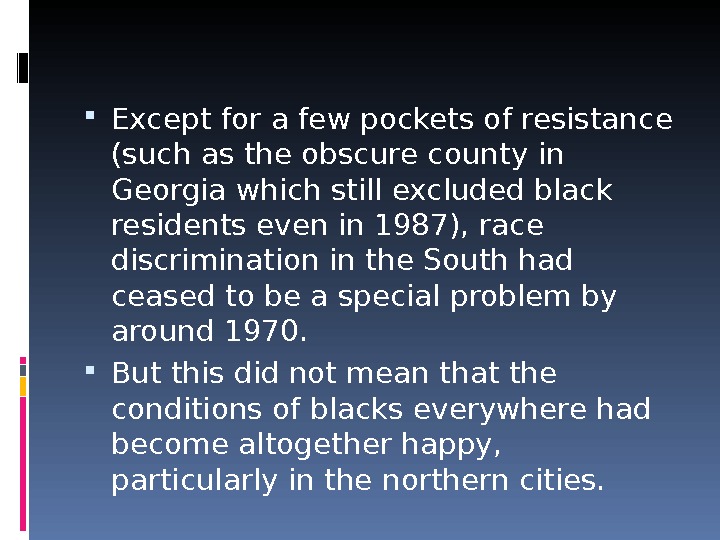
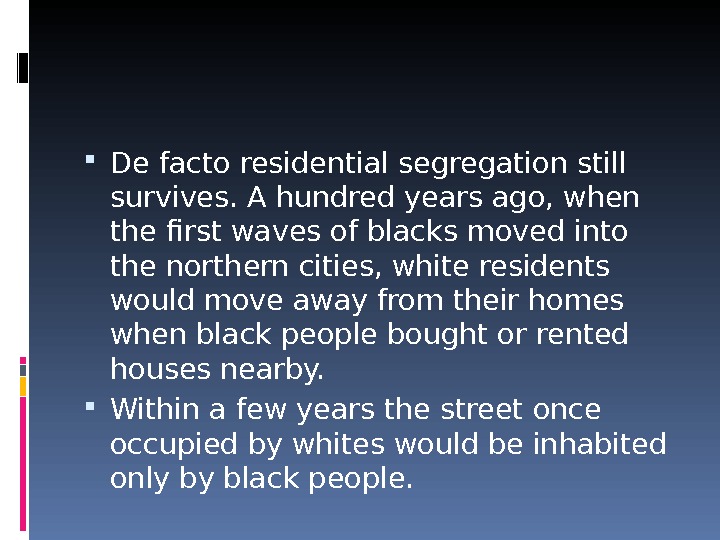
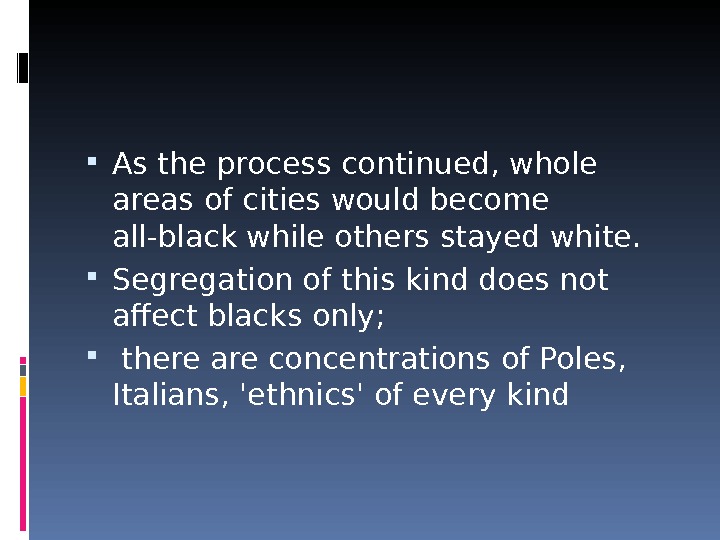
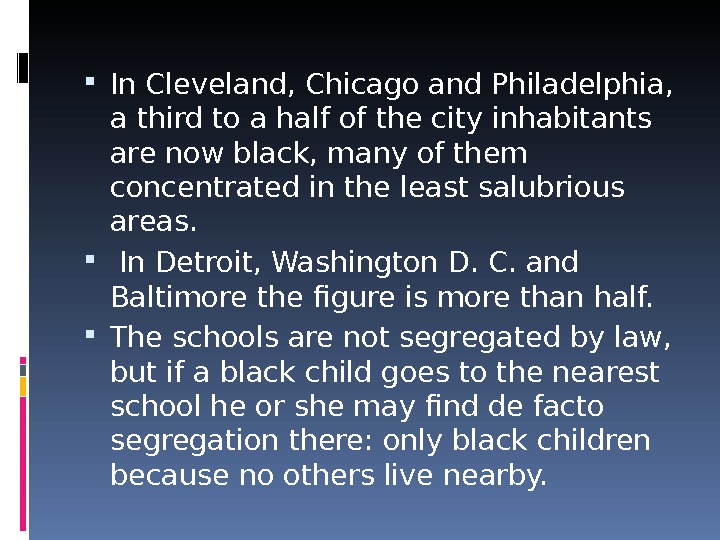

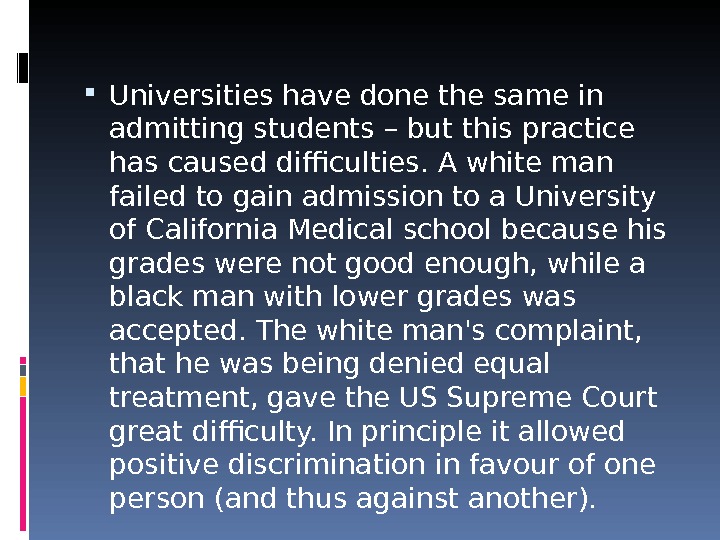

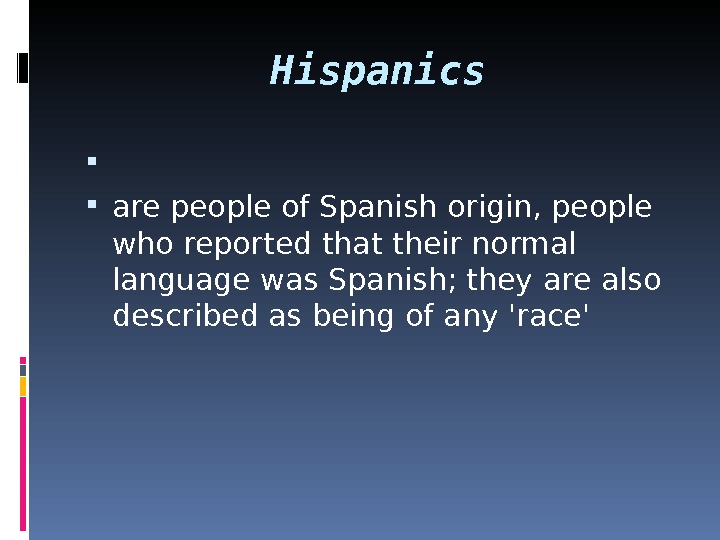
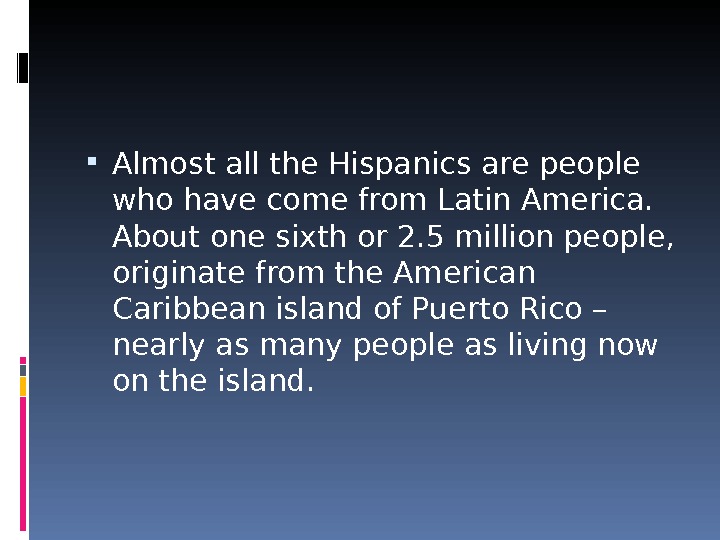
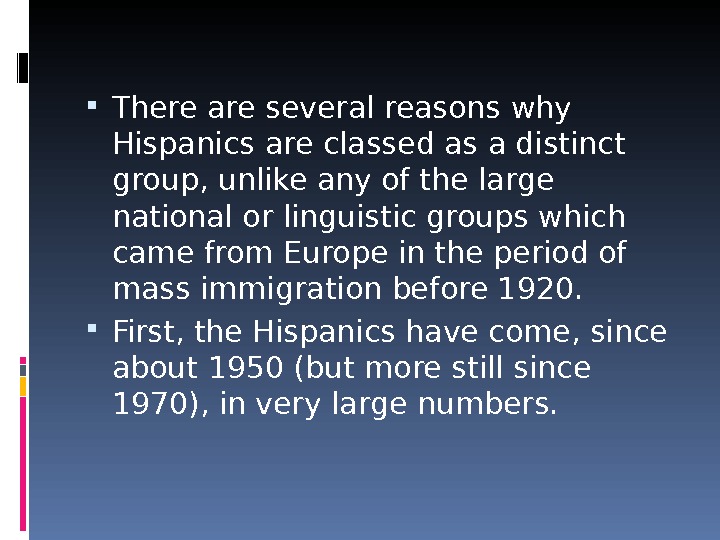
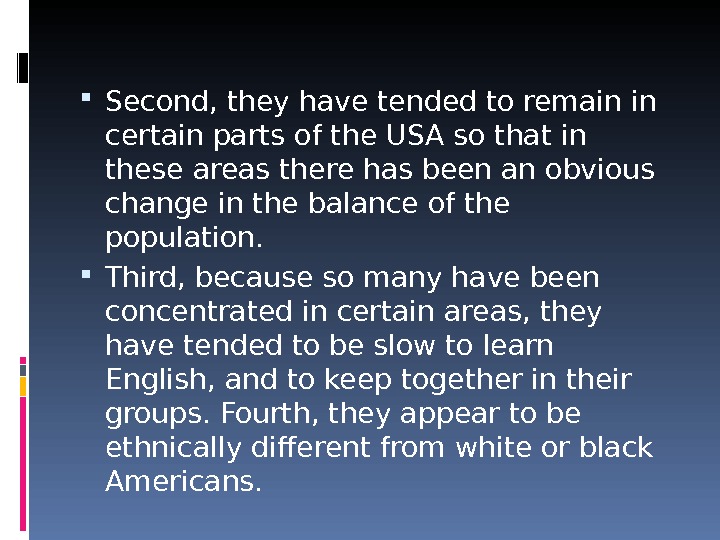
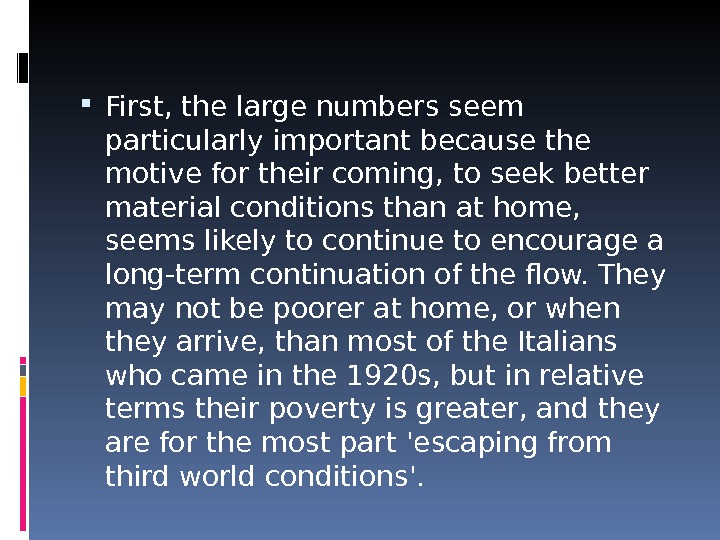
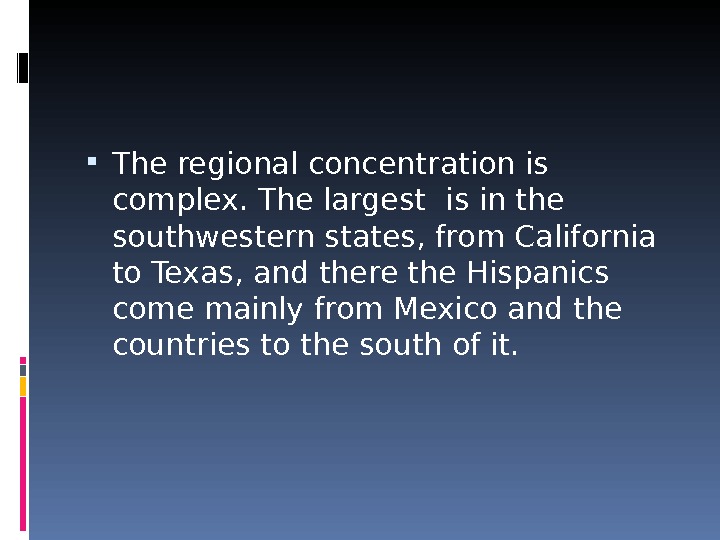
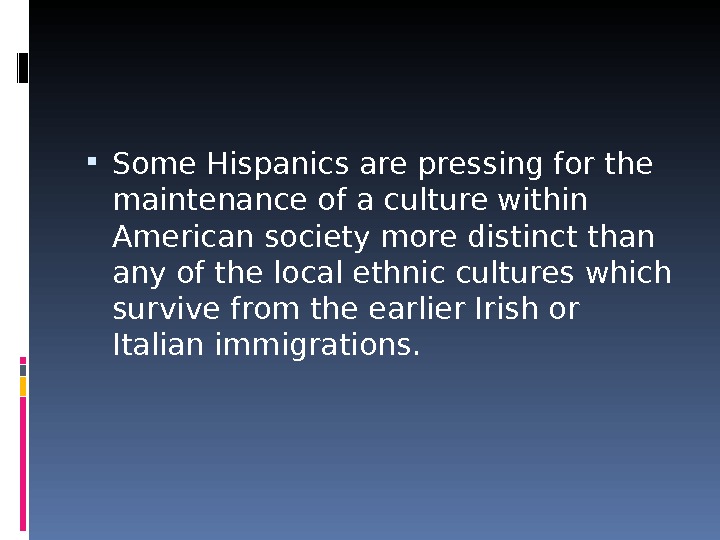
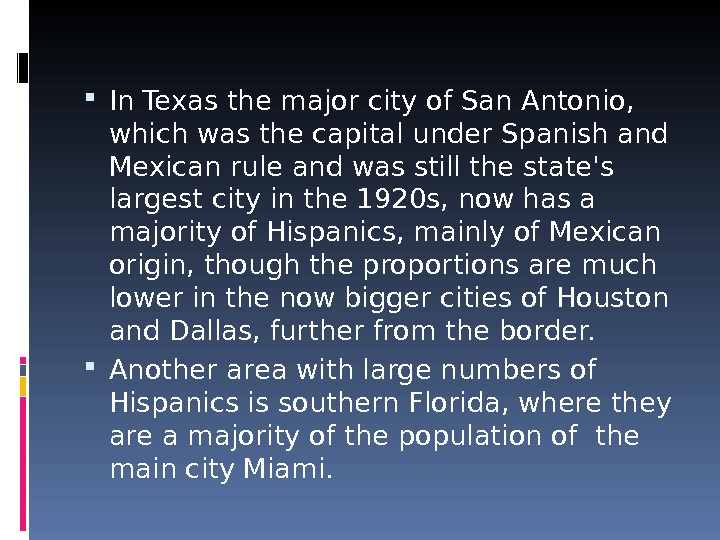


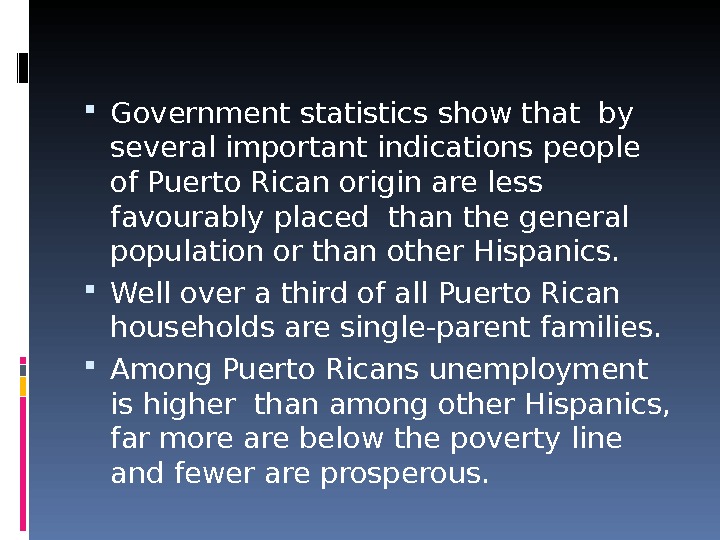
- Размер: 1.8 Mегабайта
- Количество слайдов: 74
Описание презентации People and their origins The mythology of America по слайдам
 People and their origins The mythology of America is concerned with individual effort, enterprise, adventure, a practical belief in equal respect for all people, equality of opportunity, and through the free exchange of goods, fair reward for each person’s work. The 20 th century has brought about 2 big new elements into the foundations of American life. 1. The USA has become a great power, unable to avoid involvement and responsibility in international affairs. 2. The old system of individualistic free enterprise has had to be supplemented by state intervention. But the American’s view of themselves and their ideals have not been greatly affected by these changes. Their past, and the myths connected with it still play an immediate part in their present-day life.
People and their origins The mythology of America is concerned with individual effort, enterprise, adventure, a practical belief in equal respect for all people, equality of opportunity, and through the free exchange of goods, fair reward for each person’s work. The 20 th century has brought about 2 big new elements into the foundations of American life. 1. The USA has become a great power, unable to avoid involvement and responsibility in international affairs. 2. The old system of individualistic free enterprise has had to be supplemented by state intervention. But the American’s view of themselves and their ideals have not been greatly affected by these changes. Their past, and the myths connected with it still play an immediate part in their present-day life.
 In 1497 -1498 John Cabot made 2 pioneering journeys across the North Atlantic. The first settlement of North America from Europe was slow , hesitant and without plan.
In 1497 -1498 John Cabot made 2 pioneering journeys across the North Atlantic. The first settlement of North America from Europe was slow , hesitant and without plan.
 On the first, in the ship Matthew, with a crew of 18, he reached islands off the St. Lawrence estuary in Canada. The second expedition, with several ships, sailed down the mainland coast to a point well south of what is now New York.
On the first, in the ship Matthew, with a crew of 18, he reached islands off the St. Lawrence estuary in Canada. The second expedition, with several ships, sailed down the mainland coast to a point well south of what is now New York.
 St. Lawrence estuary
St. Lawrence estuary
 John Cabot was a Venetian who had settled in England. He was financed by merchants in Bristol, and supported by the English King Henry the VII. His expedition met native Americans and bartered European goods for furs. Cabot died soon after the second voyage, and his claim that the lands he had visited belonged to England was made quite unreal by the lack of any further expeditions for many decades.
John Cabot was a Venetian who had settled in England. He was financed by merchants in Bristol, and supported by the English King Henry the VII. His expedition met native Americans and bartered European goods for furs. Cabot died soon after the second voyage, and his claim that the lands he had visited belonged to England was made quite unreal by the lack of any further expeditions for many decades.
 King Henry VII (1485 – 1509) John Cabot
King Henry VII (1485 – 1509) John Cabot
 During the 16 th century Spanish explorers went all along the western and southern coasts of North America and up the rivers. In 1609 they built a palace for the government of New Mexico on the plaza of their new town of Santa Fe, far north of the border of Mexico itself. The two thirds of the present US territory west of the Mississippi became part of the Spanish Empire, except for parts temporarily colonized by the French in the first half of the 19 th century.
During the 16 th century Spanish explorers went all along the western and southern coasts of North America and up the rivers. In 1609 they built a palace for the government of New Mexico on the plaza of their new town of Santa Fe, far north of the border of Mexico itself. The two thirds of the present US territory west of the Mississippi became part of the Spanish Empire, except for parts temporarily colonized by the French in the first half of the 19 th century.
 Some French Huguenots established themselves on the Atlantic Coast of Florida but were wiped out by a Spanish naval expedition which built a fort and founded the city of St. Augustine in 1565. Though it was Spanish for more than two hundred years it is considered to be the oldest city in the United States. Two attempts at colonizing North America from England failed in the 1580 s. The first group of settlers stayed only for a year, the second vanished, and no trace of them has ever been found.
Some French Huguenots established themselves on the Atlantic Coast of Florida but were wiped out by a Spanish naval expedition which built a fort and founded the city of St. Augustine in 1565. Though it was Spanish for more than two hundred years it is considered to be the oldest city in the United States. Two attempts at colonizing North America from England failed in the 1580 s. The first group of settlers stayed only for a year, the second vanished, and no trace of them has ever been found.
 In 1607 a London merchants’ company gathered a group of men, some of them criminals released from prison. They landed at a place which they called Jamestown, a little way up one of the rivers which flow into Chesapeake Bay, in what is now Virginia – though that name, in honour of the English Queen Elizabeth I, had already been adopted to describe the whole of North America.
In 1607 a London merchants’ company gathered a group of men, some of them criminals released from prison. They landed at a place which they called Jamestown, a little way up one of the rivers which flow into Chesapeake Bay, in what is now Virginia – though that name, in honour of the English Queen Elizabeth I, had already been adopted to describe the whole of North America.
 Chesapeake Bay
Chesapeake Bay
 The Jamestown settlers were followed by others in the next few years, and by 1620 there were about a thousand. The settlers were allowed to have their own land learned to grow tobacco. When they remember the beginnings of their nation, Americans think not so much of the rather miserable Jamestown settlement, but of the English Puritans, now known as the Pilgrim Fathers, who landed at Cape Cod near Boston, in 1620. They had first left England, after conflict with the authorities over their refusal to comply with current religious laws, and spent a dozen years in exile at Leyden, Holland.
The Jamestown settlers were followed by others in the next few years, and by 1620 there were about a thousand. The settlers were allowed to have their own land learned to grow tobacco. When they remember the beginnings of their nation, Americans think not so much of the rather miserable Jamestown settlement, but of the English Puritans, now known as the Pilgrim Fathers, who landed at Cape Cod near Boston, in 1620. They had first left England, after conflict with the authorities over their refusal to comply with current religious laws, and spent a dozen years in exile at Leyden, Holland.
 The Pilgrim Fathers landed at Cape Cod near Boston in 1620. The small ship Mayflower took them across the Atlantic.
The Pilgrim Fathers landed at Cape Cod near Boston in 1620. The small ship Mayflower took them across the Atlantic.
 In November The Mayflower reached Cape Cod, on the coast of what is now Massachusetts, and they decided to stay there, at a place near modern Boston, which they called Plymouth, after the English port from which they had sailed.
In November The Mayflower reached Cape Cod, on the coast of what is now Massachusetts, and they decided to stay there, at a place near modern Boston, which they called Plymouth, after the English port from which they had sailed.
 The Pilgrim Fathers suffered terrible hardships at first, and half of them died during their first winter months; but those who survived for the first year managed to live on fish and reap a harvest from the land in the summer, with the help of friendly native Americans. A year after they arrived, another ship came from England, and they celebrated this arrival, and the harvest they had gathered with a feast of thanksgiving.
The Pilgrim Fathers suffered terrible hardships at first, and half of them died during their first winter months; but those who survived for the first year managed to live on fish and reap a harvest from the land in the summer, with the help of friendly native Americans. A year after they arrived, another ship came from England, and they celebrated this arrival, and the harvest they had gathered with a feast of thanksgiving.
 The anniversary of their thanksgiving feast is still celebrated every November as a public holiday. Thanksgiving and Independence Day are the 2 great occasions by which Americans remember each year the 2 main stages in their national history, foundation and independence.
The anniversary of their thanksgiving feast is still celebrated every November as a public holiday. Thanksgiving and Independence Day are the 2 great occasions by which Americans remember each year the 2 main stages in their national history, foundation and independence.
 Between 1620 – 1640 the Pilgrim Fathers were followed by many more shiploads of settlers in New England. During the same period New Amsterdam was founded from Holland on the small island of Manhattan. In 1664 the English took over the colony and changed the name to New York.
Between 1620 – 1640 the Pilgrim Fathers were followed by many more shiploads of settlers in New England. During the same period New Amsterdam was founded from Holland on the small island of Manhattan. In 1664 the English took over the colony and changed the name to New York.
 The last of the main foundations came in 1682. At this time the Quakers had become the most energetic representatives in England of the Puritan tradition, and William Penn, a prominent English Quaker, led a group of religious sympathizers to settle in Pennsylvania.
The last of the main foundations came in 1682. At this time the Quakers had become the most energetic representatives in England of the Puritan tradition, and William Penn, a prominent English Quaker, led a group of religious sympathizers to settle in Pennsylvania.
 The idealistic motives which inspired the first migrants to New England in 1620 – 1640 still remain important for the American picture of themselves. These early settlers were for the most part religious people, although religion was not the only source of inspiration for their enterprise. Many wanted to escape from the oppressive religious and social atmosphere of England.
The idealistic motives which inspired the first migrants to New England in 1620 – 1640 still remain important for the American picture of themselves. These early settlers were for the most part religious people, although religion was not the only source of inspiration for their enterprise. Many wanted to escape from the oppressive religious and social atmosphere of England.
 Most of them were Protestants not ready to accept the religious practice of the Church of England which had been evolved from the Reformation. In England their beliefs caused them inconvenience and sometimes danger. When they came to America they were determined to build a new society which was free of the bad elements of the old, and preserve those elements which seemed to them good.
Most of them were Protestants not ready to accept the religious practice of the Church of England which had been evolved from the Reformation. In England their beliefs caused them inconvenience and sometimes danger. When they came to America they were determined to build a new society which was free of the bad elements of the old, and preserve those elements which seemed to them good.
 In the 18 th century the settlements along the east coast were organized as 13 th colonies, each with a governor, under British rule.
In the 18 th century the settlements along the east coast were organized as 13 th colonies, each with a governor, under British rule.
 The colonies grew and developed, many people came from Britain, Holland Germany. In fact, many of the settlers did not come willingly. Some had to serve for long periods to pay for their transport, some were convicts, transported to America instead of being hanged; some were thieves or murderers. And there was always the flood of slaves brought over from Africa and sold to work in the plantations of the South.
The colonies grew and developed, many people came from Britain, Holland Germany. In fact, many of the settlers did not come willingly. Some had to serve for long periods to pay for their transport, some were convicts, transported to America instead of being hanged; some were thieves or murderers. And there was always the flood of slaves brought over from Africa and sold to work in the plantations of the South.
 When the colonies declared their independence in 1776 they were still predominantly British in their origin and their outlook. Later immigrants of the 19 th and the 20 th centuries were for the most part not brought to America by the same ideals which inspired the Pilgrim Fathers and the settlers who went with William Penn. The people from Ireland, Poland Italy in particular, went to America in order to escape from intolerable poverty in their own home countries, and they were regarded as inferiors by the Americans of earlier generations.
When the colonies declared their independence in 1776 they were still predominantly British in their origin and their outlook. Later immigrants of the 19 th and the 20 th centuries were for the most part not brought to America by the same ideals which inspired the Pilgrim Fathers and the settlers who went with William Penn. The people from Ireland, Poland Italy in particular, went to America in order to escape from intolerable poverty in their own home countries, and they were regarded as inferiors by the Americans of earlier generations.
 Even so however different the position of the new arrivals as compared with the old, there is still an important element in common among them. All were in rebellion against something which they did not like in their own environments and all were prepared to take great risks and face great hardships in trying to build a new life for themselves.
Even so however different the position of the new arrivals as compared with the old, there is still an important element in common among them. All were in rebellion against something which they did not like in their own environments and all were prepared to take great risks and face great hardships in trying to build a new life for themselves.
 All white American-born citizens today are descended from people who at some time made a decision to move from Europe. This very fact gives them a common cultural background and they are very conscious of sharing it.
All white American-born citizens today are descended from people who at some time made a decision to move from Europe. This very fact gives them a common cultural background and they are very conscious of sharing it.
 2. The century of massive settlement: 1820 -1920 When the United States became independent in 1783 the settled part of the country consisted of farming communities spread along the east coast. The territory of the new Republic, with about 4 million people, extended only as far west as the Mississippi. The area around the Mississippi area had been so little penetrated that the French had built up their city of New Orleans early in the 18 th century.
2. The century of massive settlement: 1820 -1920 When the United States became independent in 1783 the settled part of the country consisted of farming communities spread along the east coast. The territory of the new Republic, with about 4 million people, extended only as far west as the Mississippi. The area around the Mississippi area had been so little penetrated that the French had built up their city of New Orleans early in the 18 th century.
 But in 1762 the French gave up all claims there to Spain. The Spanish took little interest in the area, and in 1803, by the “Louisiana Purchase”, the USA acquired the whole western part of the Mississippi-Missouri basin. The land purchased contained all of present day Arkansas, Missouri, Iowa, Oklahoma , Texas, Kansas, Nebraska, South Dakota, New Mexico, parts of Montana, Wyoming, Cal, Louisiana (2. 140. 000 sq. km).
But in 1762 the French gave up all claims there to Spain. The Spanish took little interest in the area, and in 1803, by the “Louisiana Purchase”, the USA acquired the whole western part of the Mississippi-Missouri basin. The land purchased contained all of present day Arkansas, Missouri, Iowa, Oklahoma , Texas, Kansas, Nebraska, South Dakota, New Mexico, parts of Montana, Wyoming, Cal, Louisiana (2. 140. 000 sq. km).
 Louisiana purchase
Louisiana purchase
 The coming of independence did not lead immediately to a great new wave of people. Probably only about 150, 000 people settled in the USA between 1789 and 1820. In 1790 over 4/5 of the population were said to be of British origin. Early American society was very British, in the sense that British ideas and ways of living had been taken to a new environment and adapted to it.
The coming of independence did not lead immediately to a great new wave of people. Probably only about 150, 000 people settled in the USA between 1789 and 1820. In 1790 over 4/5 of the population were said to be of British origin. Early American society was very British, in the sense that British ideas and ways of living had been taken to a new environment and adapted to it.
 About 1820 the flow of new settlers from Europe began to increase dramatically. Between 1820 and 1840 over a million people migrated to the USA. , nearly 10 times as many as in the previous 20 years, and many were from Ireland continental Europe. The development of steamships made the conditions of traveling easier, though by any modern standards were still terrible.
About 1820 the flow of new settlers from Europe began to increase dramatically. Between 1820 and 1840 over a million people migrated to the USA. , nearly 10 times as many as in the previous 20 years, and many were from Ireland continental Europe. The development of steamships made the conditions of traveling easier, though by any modern standards were still terrible.
 The 40 years 1840 – 1880, brought almost ten million migrants to America or a quarter of a million a year: 50 times as many as in the early years of the century. Many of the migrants of this period came from Germany, and for the rest of the 19 th century German migration was no less important than that from Great Britain.
The 40 years 1840 – 1880, brought almost ten million migrants to America or a quarter of a million a year: 50 times as many as in the early years of the century. Many of the migrants of this period came from Germany, and for the rest of the 19 th century German migration was no less important than that from Great Britain.
 There were also great numbers from Ireland escaping from the poverty and famine of their country, whose population fell rapidly during this period. The Germans , mainly Protestants, were assimilated easily enough into English-American society, but the Irish kept rather more separate.
There were also great numbers from Ireland escaping from the poverty and famine of their country, whose population fell rapidly during this period. The Germans , mainly Protestants, were assimilated easily enough into English-American society, but the Irish kept rather more separate.
 The Irish did not need to learn an entirely new language (though some were Irish-speaking), but they were nearly all Catholics, full of resentment at the domination of their own home country by the English, and particularly by the English protestant landlords. So the new Irish-Americans saved money to come and join them. Irish immigrants met some hostile prejudice after a time. They were supposed to be unreliable, and they certainly threatened the Protestant domination. There were notices outside factories: “No Irish need apply”.
The Irish did not need to learn an entirely new language (though some were Irish-speaking), but they were nearly all Catholics, full of resentment at the domination of their own home country by the English, and particularly by the English protestant landlords. So the new Irish-Americans saved money to come and join them. Irish immigrants met some hostile prejudice after a time. They were supposed to be unreliable, and they certainly threatened the Protestant domination. There were notices outside factories: “No Irish need apply”.
 For many of the migrants of this time the move involved not only a change of homeland, but a change from farm to factory, from country to town. American industry was developing rapidly from the east coast to Chicago and beyond, and many of the new migrants were involved in the factories that were growing up everywhere. By the middle of the century the USA had a larger population than any single European country, and by 1880 it reached 50 million.
For many of the migrants of this time the move involved not only a change of homeland, but a change from farm to factory, from country to town. American industry was developing rapidly from the east coast to Chicago and beyond, and many of the new migrants were involved in the factories that were growing up everywhere. By the middle of the century the USA had a larger population than any single European country, and by 1880 it reached 50 million.
 By 1880 there were large communities in which most of the adults had been born in Europe. There were some compact national groups, particularly of Germans. It might have been possible for large areas to become homes for compact ethnic groups maintaining the German language and German customs, and so building up new little Germanies on the American continent, but in practice this never happened. Groups of Germans did keep their national identity and they did live together, but they were always assimilated into the general pattern of American culture.
By 1880 there were large communities in which most of the adults had been born in Europe. There were some compact national groups, particularly of Germans. It might have been possible for large areas to become homes for compact ethnic groups maintaining the German language and German customs, and so building up new little Germanies on the American continent, but in practice this never happened. Groups of Germans did keep their national identity and they did live together, but they were always assimilated into the general pattern of American culture.
 The civil war (1861 -1865) had some influence in the development of national consciousness. The war settled the question whether the US should remain one political unit or split into two. The people newly arrived from Europe had nearly all settled in the North and could easily identify themselves with the northern position. To them the South was like a foreign country, and their share in the victory made it possible for them to have a greater consciousness of being American.
The civil war (1861 -1865) had some influence in the development of national consciousness. The war settled the question whether the US should remain one political unit or split into two. The people newly arrived from Europe had nearly all settled in the North and could easily identify themselves with the northern position. To them the South was like a foreign country, and their share in the victory made it possible for them to have a greater consciousness of being American.
 More than 3 quarters of a million people crossed as settlers in 1882 and the flow continued, with some big fluctuations. One tenth of the whole population of Sweden and Norway left for America in only ten years, 1881 — 1890. The Swedes were escaping from poverty in a northern European country which was still dominated by the aristocracy and still economically backward. Yet the very time of the great Swedish migration was also the time of the beginning of Swedish industrial development.
More than 3 quarters of a million people crossed as settlers in 1882 and the flow continued, with some big fluctuations. One tenth of the whole population of Sweden and Norway left for America in only ten years, 1881 — 1890. The Swedes were escaping from poverty in a northern European country which was still dominated by the aristocracy and still economically backward. Yet the very time of the great Swedish migration was also the time of the beginning of Swedish industrial development.
 Twelve million immigrants came in 1900 – 1914, and during the final years of the First World War, three-quarters of the new arrivals came from Eastern Europe and Italy. They were on the whole regarded as inferiors, and they were conscious of having started late in the race for wealth and prestige in the society they had come to join.
Twelve million immigrants came in 1900 – 1914, and during the final years of the First World War, three-quarters of the new arrivals came from Eastern Europe and Italy. They were on the whole regarded as inferiors, and they were conscious of having started late in the race for wealth and prestige in the society they had come to join.
 It was a great advantage at this time to be a white Anglo-Saxon Protestant (WASP), and a disadvantage to be a Catholic or a Jew, or from Italy or from Eastern Europe. These new groups often lived in communities. Being different in so many obvious ways from the established Americans, they found it hard to get themselves accepted.
It was a great advantage at this time to be a white Anglo-Saxon Protestant (WASP), and a disadvantage to be a Catholic or a Jew, or from Italy or from Eastern Europe. These new groups often lived in communities. Being different in so many obvious ways from the established Americans, they found it hard to get themselves accepted.
 3. Immigration since 1920 After the First World War, migration from Europe was on a much smaller scale. In 1921 new rules restricted the number of immigration allowed from each country – and favoured northern Europeans. They allowed less than 6, 000 people a year from Italy, but ten times as many from Britain – though the quotas were amended after 1929.
3. Immigration since 1920 After the First World War, migration from Europe was on a much smaller scale. In 1921 new rules restricted the number of immigration allowed from each country – and favoured northern Europeans. They allowed less than 6, 000 people a year from Italy, but ten times as many from Britain – though the quotas were amended after 1929.
 But soon the great depression the Second World War, played their part in restricting the flow further still, and since then the small numbers coming from Europe have been very different from the earlier generations. Professors, engineers, scientists and doctors have come , particularly form Britain, to better conditions of work and much higher pay than they would find in Europe.
But soon the great depression the Second World War, played their part in restricting the flow further still, and since then the small numbers coming from Europe have been very different from the earlier generations. Professors, engineers, scientists and doctors have come , particularly form Britain, to better conditions of work and much higher pay than they would find in Europe.
 Intellectuals and specialists of every kind have brought their special skills to reinforce American industry, commerce, education, research, arts and entertainment. Many of these people have received their education and training at the expense of the taxpayers of their own home countries.
Intellectuals and specialists of every kind have brought their special skills to reinforce American industry, commerce, education, research, arts and entertainment. Many of these people have received their education and training at the expense of the taxpayers of their own home countries.
 Immigration from Europe has declined even more since 1950 s, though the flow of doctors, nurses and scientists from Britain caused anxiety in that country about what is called the ‘brain drain’ to America. Fewer European settlers came in the 15 years form 1970 to 1985 than in one year of 1907. One reason for the change is the increasing prosperity of Western Europe, another the difficulty of leaving Eastern Europe.
Immigration from Europe has declined even more since 1950 s, though the flow of doctors, nurses and scientists from Britain caused anxiety in that country about what is called the ‘brain drain’ to America. Fewer European settlers came in the 15 years form 1970 to 1985 than in one year of 1907. One reason for the change is the increasing prosperity of Western Europe, another the difficulty of leaving Eastern Europe.
 Meanwhile, the main sources of immigration have been increasingly outside Europe, mainly Central America and the Caribbean but also Asia, and to a lesser extent from Africa. By the 1960 s quite large numbers had come from the American Caribbean Island of Puerto Rico, and then after 1959, many thousands of opponents of the new regime in Cuba were accepted as refugees. At that time it was widely felt that the old immigration policy had been racist. In response to this, quotas for countries in Africa and Asia were increased or allowed for the 1 st time.
Meanwhile, the main sources of immigration have been increasingly outside Europe, mainly Central America and the Caribbean but also Asia, and to a lesser extent from Africa. By the 1960 s quite large numbers had come from the American Caribbean Island of Puerto Rico, and then after 1959, many thousands of opponents of the new regime in Cuba were accepted as refugees. At that time it was widely felt that the old immigration policy had been racist. In response to this, quotas for countries in Africa and Asia were increased or allowed for the 1 st time.
 In 1987 a new form of indirect control of immigration was brought into effect, against the wishes of some business interests as well as humanitarian liberals. It became a punishable offence to employ people without proper documentation. As a result, the number of people caught trying to enter the USA illegally from Mexico declined, Meanwhile, people who can show that they have worked in the US for 5 years can apply for, and normally obtain documents entitling them to stay and eventually to apply for naturalization as US citizen.
In 1987 a new form of indirect control of immigration was brought into effect, against the wishes of some business interests as well as humanitarian liberals. It became a punishable offence to employ people without proper documentation. As a result, the number of people caught trying to enter the USA illegally from Mexico declined, Meanwhile, people who can show that they have worked in the US for 5 years can apply for, and normally obtain documents entitling them to stay and eventually to apply for naturalization as US citizen.
 4. The American Identity The Europeans American Indians Black Americans Hispanics Asians
4. The American Identity The Europeans American Indians Black Americans Hispanics Asians
 The Europeans About 3 quarters of all US citizens are descended wholly and directly from people born in Europe. Because of the low level of immigration from Europe in the past seventy years the white Americans, considered as a group, are collectively more remote from their European origins than at any time since mass migration from Europe began in the 19 th century. But this does not mean that they have all lost all contact with their European past.
The Europeans About 3 quarters of all US citizens are descended wholly and directly from people born in Europe. Because of the low level of immigration from Europe in the past seventy years the white Americans, considered as a group, are collectively more remote from their European origins than at any time since mass migration from Europe began in the 19 th century. But this does not mean that they have all lost all contact with their European past.
 Surveys show that about half have no consciousness of being connected by descent with any country in particular. Some of these know that they are of mixed descent, others have no contact with any countries across the Atlantic, or no knowledge of their origins. Of those who consider themselves to have an identifiable origin in some particular country the biggest single national group, even now, feel ‘British’ – just over a tenth of the whole population. Almost as many feel ‘German’. There also people who feel “Dutch”, “Swedish”, etc.
Surveys show that about half have no consciousness of being connected by descent with any country in particular. Some of these know that they are of mixed descent, others have no contact with any countries across the Atlantic, or no knowledge of their origins. Of those who consider themselves to have an identifiable origin in some particular country the biggest single national group, even now, feel ‘British’ – just over a tenth of the whole population. Almost as many feel ‘German’. There also people who feel “Dutch”, “Swedish”, etc.
 The definition of “Ethnics” People who are still strongly identified with a national origin other than northwestern European are commonly called ‘ethnics’ – though the term cannot be rigidly defined. There has been so much marriage outside the ethnic groups that not every person with a Greek surname can properly be regarded as an ethnic Greek. Ethnics may keep some qualities which distinguish them from ‘Wasps’, and be none the less American for this distinctiveness.
The definition of “Ethnics” People who are still strongly identified with a national origin other than northwestern European are commonly called ‘ethnics’ – though the term cannot be rigidly defined. There has been so much marriage outside the ethnic groups that not every person with a Greek surname can properly be regarded as an ethnic Greek. Ethnics may keep some qualities which distinguish them from ‘Wasps’, and be none the less American for this distinctiveness.
 American Indians In general, the American Indians have resisted assimilation, and have preferred to keep themselves separate, with their own distinct way of life. Today there about 1, 5 million Amerindians, or around half of one percent of the US population, and about half of them live in areas, designated as reservations. Others, including some who live in reservations, take part in the dominant economy. There has been some intermarriage, but not much.
American Indians In general, the American Indians have resisted assimilation, and have preferred to keep themselves separate, with their own distinct way of life. Today there about 1, 5 million Amerindians, or around half of one percent of the US population, and about half of them live in areas, designated as reservations. Others, including some who live in reservations, take part in the dominant economy. There has been some intermarriage, but not much.
 Many live by farming, or by making jewellery and ornaments which they sell to tourists. Federal and state governments spend generously in providing them with services and in encouraging their various enterprises. In general the Indians in the reservations remain outside the mainstream of economic development, yet enjoy the level of comfort that they can derive from the general wealth of society as a whole.
Many live by farming, or by making jewellery and ornaments which they sell to tourists. Federal and state governments spend generously in providing them with services and in encouraging their various enterprises. In general the Indians in the reservations remain outside the mainstream of economic development, yet enjoy the level of comfort that they can derive from the general wealth of society as a whole.
 Towards the 1800 the southern states stopped the trade, and from then onwards no more slave ships came in, except for a few which came illegally. Southern slavery was ended only with the victory of the northern states in the civil war of 1861 -1865. The US Constitution was amended so as to outlaw slavery, and to grant automatic citizenship to any person born in the USA.
Towards the 1800 the southern states stopped the trade, and from then onwards no more slave ships came in, except for a few which came illegally. Southern slavery was ended only with the victory of the northern states in the civil war of 1861 -1865. The US Constitution was amended so as to outlaw slavery, and to grant automatic citizenship to any person born in the USA.
 But long after 1865 the whites in most of the South were still finding ways of excluding black citizens from real equality. Even in the 1950 s there were cases of southern black people being intimidated when they came to register as voters; In the South they were still separate schools, separate seats in local buses, even separate hospital car parks – and many whites-only facilities of many kinds.
But long after 1865 the whites in most of the South were still finding ways of excluding black citizens from real equality. Even in the 1950 s there were cases of southern black people being intimidated when they came to register as voters; In the South they were still separate schools, separate seats in local buses, even separate hospital car parks – and many whites-only facilities of many kinds.
 Black opposition to discrimination was led by the National Association for the Advancement of Coloured People, with strong support from liberally-minded whites. The 1950 s brought the beginnings of major change. At this time a black clergyman, Martin Luther King, became the informal leader of active movements of non-violent protest against racial segregation, and he gained admiring support from white Americans in the South as well as in the North.
Black opposition to discrimination was led by the National Association for the Advancement of Coloured People, with strong support from liberally-minded whites. The 1950 s brought the beginnings of major change. At this time a black clergyman, Martin Luther King, became the informal leader of active movements of non-violent protest against racial segregation, and he gained admiring support from white Americans in the South as well as in the North.
 King came to the center of the stage at the time when television was becoming widely available. When defenders of the white supremacist traditions of the South reacted violently against a peaceful campaign for equal treatment, television showed the unpleasant scenes which they provoked. When the University of Mississippi admitted its first black student in 1962, he met with such threats of violence that he had to be protected by large groups of armed soldiers wherever he went.
King came to the center of the stage at the time when television was becoming widely available. When defenders of the white supremacist traditions of the South reacted violently against a peaceful campaign for equal treatment, television showed the unpleasant scenes which they provoked. When the University of Mississippi admitted its first black student in 1962, he met with such threats of violence that he had to be protected by large groups of armed soldiers wherever he went.
 After the assassination of John F. Kennedy in 1963, his successor as President Lyndon Johnson, expanded his ideas and led Congress to pass laws to eliminate racial discrimination. In 1969, Luther King became a martyr too, and like Kennedy was assassinated. Later the US Congress set aside one day each year as a national holiday in his memory – an honour given to only one other man, George Washington, the nation’s first president.
After the assassination of John F. Kennedy in 1963, his successor as President Lyndon Johnson, expanded his ideas and led Congress to pass laws to eliminate racial discrimination. In 1969, Luther King became a martyr too, and like Kennedy was assassinated. Later the US Congress set aside one day each year as a national holiday in his memory – an honour given to only one other man, George Washington, the nation’s first president.
 By the 1970 s blacks were registered as voters in the South in almost the same proportion as whites. Soon many were elected to important offices in the southern states, Blacks have been elected as mayors of several of the country’s biggest cities (including Chicago, Philadelphia, Detroit, Cleveland Washington D. C. ).
By the 1970 s blacks were registered as voters in the South in almost the same proportion as whites. Soon many were elected to important offices in the southern states, Blacks have been elected as mayors of several of the country’s biggest cities (including Chicago, Philadelphia, Detroit, Cleveland Washington D. C. ).
 Except for a few pockets of resistance (such as the obscure county in Georgia which still excluded black residents even in 1987), race discrimination in the South had ceased to be a special problem by around 1970. But this did not mean that the conditions of blacks everywhere had become altogether happy, particularly in the northern cities.
Except for a few pockets of resistance (such as the obscure county in Georgia which still excluded black residents even in 1987), race discrimination in the South had ceased to be a special problem by around 1970. But this did not mean that the conditions of blacks everywhere had become altogether happy, particularly in the northern cities.
 De facto residential segregation still survives. A hundred years ago, when the first waves of blacks moved into the northern cities, white residents would move away from their homes when black people bought or rented houses nearby. Within a few years the street once occupied by whites would be inhabited only by black people.
De facto residential segregation still survives. A hundred years ago, when the first waves of blacks moved into the northern cities, white residents would move away from their homes when black people bought or rented houses nearby. Within a few years the street once occupied by whites would be inhabited only by black people.
 As the process continued, whole areas of cities would become all-black while others stayed white. Segregation of this kind does not affect blacks only; there are concentrations of Poles, Italians, ‘ethnics’ of every kind
As the process continued, whole areas of cities would become all-black while others stayed white. Segregation of this kind does not affect blacks only; there are concentrations of Poles, Italians, ‘ethnics’ of every kind
 In Cleveland, Chicago and Philadelphia, a third to a half of the city inhabitants are now black, many of them concentrated in the least salubrious areas. In Detroit, Washington D. C. and Baltimore the figure is more than half. The schools are not segregated by law, but if a black child goes to the nearest school he or she may find de facto segregation there: only black children because no others live nearby.
In Cleveland, Chicago and Philadelphia, a third to a half of the city inhabitants are now black, many of them concentrated in the least salubrious areas. In Detroit, Washington D. C. and Baltimore the figure is more than half. The schools are not segregated by law, but if a black child goes to the nearest school he or she may find de facto segregation there: only black children because no others live nearby.
 Discrimination against blacks, both in admission to all public places and in employment, is now illegal. In some police forces and many northern and southern state and national government departments, blacks have been systematically and openly favoured for promotion, and where there have been promotion examinations to be passed, the minimum grade has been set at a lower level for blacks than for whites.
Discrimination against blacks, both in admission to all public places and in employment, is now illegal. In some police forces and many northern and southern state and national government departments, blacks have been systematically and openly favoured for promotion, and where there have been promotion examinations to be passed, the minimum grade has been set at a lower level for blacks than for whites.
 Universities have done the same in admitting students – but this practice has caused difficulties. A white man failed to gain admission to a University of California Medical school because his grades were not good enough, while a black man with lower grades was accepted. The white man’s complaint, that he was being denied equal treatment, gave the US Supreme Court great difficulty. In principle it allowed positive discrimination in favour of one person (and thus against another).
Universities have done the same in admitting students – but this practice has caused difficulties. A white man failed to gain admission to a University of California Medical school because his grades were not good enough, while a black man with lower grades was accepted. The white man’s complaint, that he was being denied equal treatment, gave the US Supreme Court great difficulty. In principle it allowed positive discrimination in favour of one person (and thus against another).
 By now a generation has passed since the great reforms of the 1960 s, and the general enthusiasm that supported them has tended to dry up.
By now a generation has passed since the great reforms of the 1960 s, and the general enthusiasm that supported them has tended to dry up.
 Hispanics are people of Spanish origin, people who reported that their normal language was Spanish; they are also described as being of any ‘race’
Hispanics are people of Spanish origin, people who reported that their normal language was Spanish; they are also described as being of any ‘race’
 Almost all the Hispanics are people who have come from Latin America. About one sixth or 2. 5 million people, originate from the American Caribbean island of Puerto Rico – nearly as many people as living now on the island.
Almost all the Hispanics are people who have come from Latin America. About one sixth or 2. 5 million people, originate from the American Caribbean island of Puerto Rico – nearly as many people as living now on the island.
 There are several reasons why Hispanics are classed as a distinct group, unlike any of the large national or linguistic groups which came from Europe in the period of mass immigration before 1920. First, the Hispanics have come, since about 1950 (but more still since 1970), in very large numbers.
There are several reasons why Hispanics are classed as a distinct group, unlike any of the large national or linguistic groups which came from Europe in the period of mass immigration before 1920. First, the Hispanics have come, since about 1950 (but more still since 1970), in very large numbers.
 Second, they have tended to remain in certain parts of the USA so that in these areas there has been an obvious change in the balance of the population. Third, because so many have been concentrated in certain areas, they have tended to be slow to learn English, and to keep together in their groups. Fourth, they appear to be ethnically different from white or black Americans.
Second, they have tended to remain in certain parts of the USA so that in these areas there has been an obvious change in the balance of the population. Third, because so many have been concentrated in certain areas, they have tended to be slow to learn English, and to keep together in their groups. Fourth, they appear to be ethnically different from white or black Americans.
 First, the large numbers seem particularly important because the motive for their coming, to seek better material conditions than at home, seems likely to continue to encourage a long-term continuation of the flow. They may not be poorer at home, or when they arrive, than most of the Italians who came in the 1920 s, but in relative terms their poverty is greater, and they are for the most part ‘escaping from third world conditions’.
First, the large numbers seem particularly important because the motive for their coming, to seek better material conditions than at home, seems likely to continue to encourage a long-term continuation of the flow. They may not be poorer at home, or when they arrive, than most of the Italians who came in the 1920 s, but in relative terms their poverty is greater, and they are for the most part ‘escaping from third world conditions’.
 The regional concentration is complex. The largest is in the southwestern states, from California to Texas, and there the Hispanics come mainly from Mexico and the countries to the south of it.
The regional concentration is complex. The largest is in the southwestern states, from California to Texas, and there the Hispanics come mainly from Mexico and the countries to the south of it.
 Some Hispanics are pressing for the maintenance of a culture within American society more distinct than any of the local ethnic cultures which survive from the earlier Irish or Italian immigrations.
Some Hispanics are pressing for the maintenance of a culture within American society more distinct than any of the local ethnic cultures which survive from the earlier Irish or Italian immigrations.
 In Texas the major city of San Antonio, which was the capital under Spanish and Mexican rule and was still the state’s largest city in the 1920 s, now has a majority of Hispanics, mainly of Mexican origin, though the proportions are much lower in the now bigger cities of Houston and Dallas, further from the border. Another area with large numbers of Hispanics is southern Florida, where they are a majority of the population of the main city Miami.
In Texas the major city of San Antonio, which was the capital under Spanish and Mexican rule and was still the state’s largest city in the 1920 s, now has a majority of Hispanics, mainly of Mexican origin, though the proportions are much lower in the now bigger cities of Houston and Dallas, further from the border. Another area with large numbers of Hispanics is southern Florida, where they are a majority of the population of the main city Miami.
 But here they are mainly immigrants from Cuba, opponents of the communist regime established after Fidel Castro’s revolution in 1959. Florida’s Cubans have little in common with the majority of the people who have come from Central America to the southwestern United States. Many of the Cubans came from that country’s business and professional elements, with skills and qualifications which were useful in their new American environment.
But here they are mainly immigrants from Cuba, opponents of the communist regime established after Fidel Castro’s revolution in 1959. Florida’s Cubans have little in common with the majority of the people who have come from Central America to the southwestern United States. Many of the Cubans came from that country’s business and professional elements, with skills and qualifications which were useful in their new American environment.
 Outside the Southwest and Florida, the only places with substantial Hispanic population are new York and Chicago. Most of New York’s Hispanics are originally from Puerto Rico. The position with Chicago is similar, though in that city Hispanics are outnumbered more than twice over by blacks.
Outside the Southwest and Florida, the only places with substantial Hispanic population are new York and Chicago. Most of New York’s Hispanics are originally from Puerto Rico. The position with Chicago is similar, though in that city Hispanics are outnumbered more than twice over by blacks.
 Government statistics show that by several important indications people of Puerto Rican origin are less favourably placed than the general population or than other Hispanics. Well over a third of all Puerto Rican households are single-parent families. Among Puerto Ricans unemployment is higher than among other Hispanics, far more are below the poverty line and fewer are prosperous.
Government statistics show that by several important indications people of Puerto Rican origin are less favourably placed than the general population or than other Hispanics. Well over a third of all Puerto Rican households are single-parent families. Among Puerto Ricans unemployment is higher than among other Hispanics, far more are below the poverty line and fewer are prosperous.

